COMPOSITION PORTFOLIO by CORINNE JANE COOPER submitted in accordance with the requirements for the degree of MASTER OF MUSIC at RHODES UNIVERSITY
SUPERVISOR: PROF JEFFREY BRUKMAN MARCH 2020
Acknowledgements
My sincere thanks to my supervisor, Professor Jeffrey Brukman, for all his help and advice, and to Christine Dixie, who entrusted me with creating the musical accompaniment to her multi-media installations. Her work, is quite literally, the inspiration for these works. Thank you also, to Michael Wynne for all his encouragement and support. I dedicate this portfolio to my father, J. Neil Cooper.

Table of Contents
Acknowledgements
Notes
Introduction
Portfolio
Composition Method for Worlding the White Spirit Maiden
Worlding the White Spirit Maiden
iThe Observer
ii Velázquez
iiiThe Hip Hop Handmaiden
ivThe Princess
vThe Plague Doctor
viThe Dwarf
viiThe Midget
ViiiCerberus
IxCharon
XThe Chaperone
XiThe Bodyguard
To Be King
References
In June 2014, I was introduced to Christine Dixie by a film maker I had worked with on a previous project. Christine was looking for a composer who could arrange a soundtrack around musical themes that she had commissioned from Jared Lang to accompany her video installation To Be King (Dixie 2014). Jared composed five different melodies that I wove into a palette of sounds that comprised the soundtrack. To Be King was exhibited at the National Arts Festival in 2014 as part of the Main Festival. It moved to Cape Town in 2015 and 2017, to Venice and London in 2017, and to Lithuania in 2018.
In 2017, Christine approached me to compose a soundtrack for a different work, based again on seventeenth century Spanish artist, Velázquez’ painting ‘Las Meninas’ (1656), but this time, using a series of sculptures representing the different figures in the painting, a reinterpretation with strong Eastern Cape (South Africa) themes and associations. Christine proposed reimagining the figures in the painting by clothing them in Shweshwe1 material and placing African masks on each of them, masks that she had sought out during her travels around Africa. The use of Shweshwe material, ties the figures very closely to the Eastern Cape, and in particular, close to where I grew up in Alice, just 60 kilometres away from where it is manufactured in King William’s Town. Alice is important in the unfolding of this portfolio as Ntsikana, purportedly the first Xhosa person to be converted to Christianity and a prophet, lived in Peddie (which is about 70 kilometers from Grahamstown and Rhodes University) and Gqora, near the Kat River District which is located in the Amathola District near Alice. (Kumalo 2015, p.26). Alice is steeped in history, and is the town where Lovedale Mission Station was founded in 1824 and later, the Lovedale Press in 1861. Therefore, this project felt close to my roots, hence this interaction between Western and African cultures is very relevant to my world view and has impacted on my scoring of this music. I was initially challenged by the idea that the project would require a deeper understanding of traditional Xhosa music and while I had been exposed to Xhosa culture while growing up in Alice, my formative years were largely shaped by the culture of my Christian parents who immigrated to South Africa from England during the 1960s. During the first decade of the twentieth century, in my capacity as a sound engineer, I was tasked with recording and mastering a double CD called The Bow Project. Various South African composers were invited to transcribe and paraphrase
‘Indigo Cloth emerged in South Africa after 1652 and since the 1840's shoeshoe or isiShweshwe became1 heavily influenced by French and German missionaries. Xhosa women gradually added the Blue Print to their red Blanket Clothing and further integrated the use of Shweshwe into traditional Xhosa weddings and culture.’ Da Gama Textiles (2018)
Introduction
1
or reimagine traditional Xhosa bow music for the classical string quartet. The uhadi songs2 of Nofinishi Dywili formed the basis for many of these intercultural explorations, and I recorded and mastered the string quartets as well as 12 individual recordings of Dywili’s music. I spent many hours listening to Dywili’s recordings while I mastered them, but though I was very familiar with how they sounded, I realised, as I started compiling this portfolio, that I was not familiar with their notation and rhythmic structures. I approach sound engineering with a very different ear and sonic perspective to that of a composer.
To learn more about uhadi bow music I visited the International Library of African Music (ILAM) which is housed by Rhodes University in Grahamstown, Eastern Cape. Here I consulted with sound engineer and African music specialist, Elijah Madiba, on Xhosa instruments and traditional music-making. With Madiba’s assistance I listened carefully to different bow performances and examined a variety of instruments. After this introduction I loaned a selection of recordings from the ILAM collection and listened to them as carefully as I could. Every time I listened, I seemed to hear something different, both melodically and rhythmically. To gain a deeper understanding of how this music was created I decided to transcribe some of the songs.
Following a steep learning curve I completed transcriptions of two songs with my transcriptions including a wealth of vocal parts. As my ears grew accustomed to the sound world I heard additional counter melodies. Notating the rhythms using staff notation was challenging, as this music is created according to a different format, but I am familiar with staff notation and if I was going to use this material while composing then I needed to remain with that which was familiar. I finally settled on notating with shifting time signatures and the first song is scored in bars of 3/4, 4/4, and 2/4 while the other song uses 3/4, 2/4. It was a very worthwhile exercise and after completion I humbly set about composing the eleven pieces that would musically express Dixie’s new work: Worlding the White Spirit Maiden (2019).
Composition Method for Worlding the White Spirit Maiden
The composition is founded on 29 tracks of audio, some of which were pre-recorded and supplied to me, and others that I recorded for use in the composition.
The uhadi bow is a traditional instrument of the Xhosa people of the Eastern Cape region, and is an2 overtone instrument consisting of a light-weight single brass string bow attached to a resonator gourd with a wide mouth facing away from the string. (African Musical Instruments2009)
2
The pre-recorded audio of Xhosa traditional bow playing and singing was supplied to me by ILAM. In this reflexive document I have referred to the ILAM audio by the reference numbers Elijah Madiba supplied me. While I used high sampling rates and high bit depth resolutions, the pre-recorded material was not available in high quality audio as it had been transferred from tape machines and vinyl players. I did not apply any restoration processes to this audio as these processes may have interfered with the integrity of the original audio and how it was recorded in situ using old (mainly 1950s) audio recording equipment, which is fundamental to the accurate preservation of Ethnomusicological material.
The audio I recorded used converters by RME with sampling rates of 44.1kHZ and a bit depth of 24 bits. I also made use of microphone preamps by Mackie, and pre-recorded sounds of different planets, as recorded by the National Aeronautics and Space Administration of the United States Federal Government (NASA). These were used to represent the different figures in Velázquez’s painting. Planets radiate electromagnetic waves which are able to travel through a vacuum. NASA designed instruments able to record these electro-magnetic vibrations through the vacuum that is space. These recordings were converted into sound waves that are audible to humans. The recordings that I used were downloaded in mp4 format.
I composed using a keyboard connected to a computer via a MIDI (Musical Instrument Digital Interface) and used Cubase Studio 5 for To Be King and Cubase Pro 10 for Worlding The White Spirit Maiden. I also used these two Cubase packages to edit the MIDI data I recorded. I did not use pre-recorded or supplied MIDI loops and wrote all the MIDI notes myself using instrument samples by Native Instruments (Absynth, Kontakt,3 Massive, Battery and Reaktor players) and Steinberg (Halion and Retrologue players) that are all Virtual Studio Technology (VST ) instruments.4
Using VST instruments, while economical and convenient, is not without challenges, and I spent many hours manipulating the sounds of various instruments as I became “caught up” with how the works sounded.
Native Instruments is a developer, manufacturer, and supplier of music software and hardware. 3
Virtual Studio Technology is an audio software interface that enables the use of software synthesizers and4 effects in digital audio workstations.
3 Figure 2
Through this experience I was able to compose using a wide selection of instruments as many more were available to me at the click of a mouse button. I have used 70 different VST instruments and have been able to experiment with a larger than usual spectrum of sound types. In some instances I have deviated from my classical roots leaning heavily on synthesis and exposure to Xhosa music, so that traditional boundaries are diluted and in some instances music is created merely to evoke certain moods and emotions.
Portfolio
1 Worlding the White Spirit Maiden
‘My intention would be to discover what possibilities the interweaving of references across time and space might convey about hauntings of the past in the South African present.’’ (Dixie 2018:1). In describing the Eastern Cape of South Africa, the novelist J M Coetzee, writes in Stranger Shores of the historical narrative, Frontiers by Noel Mostert that, ‘[K]nown as Frontier country [Eastern Cape], the [nineteenth century] colonists, [embarked on] the most tragically disastrous and tarnished involvement between Britain and a sovereign black people in Africa in the 19th century.’ It is this involvement whose ‘shadows continue to move with unappeased restlessness within the haunted house that is modern South Africa.’ (Coetzee 2001:338). Dixie sets her project in this “haunted house” but does not limit it to this historical period or geographical location. She sets it rather in a term taken from the genre of Magic Realism, ‘historically a literary form,[that] can be repurposed into a visual language.’ (Dixie 2012) Zamora and Faris describe Magic Realism as, ‘...a mode suited to exploring - and transgressing - boundaries, whether the boundaries are ontological, political, geographical or generic (they) facilitate the fusion, or coexistence, of possible worlds, spaces, systems that would be irreconcilable in other modes of fiction. (Zamora and Faris 1995:5)
(Dixie 2018:8) continues stating that
The representations whose history I would be rummaging through range from Greek myth to contemporary Kwaito but would focus on colonial imagery related to seventeenth century imperialism, in particular Spanish and British expeditions and how they collide and merge with contemporary and local Eastern Cape place, history and sound … My interest in representation as a construct from a postcolonial perspective is not coincidentally linked to the period of the seventeenth century in which Las Meninas was produced. It was during this era that ‘representation’ is framed and problematized. These questions of what lies within
4
and without the frame – who controls the gaze coincides historically with the beginning of the formalizing of the colonial project.
Later in Dixie’s exegesis she explains that ‘[T]he commodification of the African mask and its ambiguous status (depending who is looking at it) as craft or art, artefact or sculptural object is a debate that is echoed in a focus on trade in my exhibition, The Santiago Cross – Invisible trade.’ (Dixie 2018:10)
Foucault, in his book The Order Of Things wrote ‘These three 'observing' functions [the model's gaze, the spectator's gaze and the gaze of the represented painter come together in a point exterior to the picture: that is, an ideal point in relation to what is represented, but a perfectly real one too, since it is also the starting-point that makes the representation possible.’ (Foucault 1966: 452).
Foucault’s concept of heterotopia is an attempt to identify the features of a range of sociocultural spaces that behave in a different kind of way from most other spaces, acting as enclosed worlds within worlds and mirroring what is outside but at the same time converting it into something different. A good example are modern cemeteries: ‘ They are sites as much about time as space: bounded, designed like miniature cities, housing the dead in individual plots, steeped in ritual, bearing permanent memorials to the transient and a final rites of passage.’ (Johnson 2016:1).
The Dwarf figure in the painting, given a telescope by Dixie, prompted me to associate the different figures in the painting with different planets. The planets are universal, observed by all and represent a timelessness, as does Las Meninas (Velázquez). I imagined the Dwarf as a grounded and spiritual person, who might be standing on earth surveying the solar system. Present in the painting to the right of the Dwarf figure is the Midget figure, speculated to have been her son. As the moon orbits the earth continuously, it made sense to me that he should be represented by the moon. Using software developed by Solar System Scope, which enables one to scan through the positions of moons, planets and stars in Earth’s galaxy using a time frame, I endeavoured to find positions of the various planets to the Earth that would suit the positions of the various figures in the painting.
I was particularly interested in finding a calendar date where the Princess could be represented by the sun, the Dwarf by the earth, and the menina on the right hand side by
5
a planet between them. I also wanted to find a date that was relevant to the painting, the Eastern Cape in South Africa, Grahamstown and Spain. I settled on Princess Margarita’s birth date, 12 July 1651, and found that at 16h47, the planets lined up in such a way that Margarita could be represented by the sun, the menina on the right hand side by the planet Mercury, and the Dwarf by planet Earth. The moon at this time, was situated north west of the Earth. While it would have been preferable for the moon to have been situated east of the Earth, that would have resulted in planet Mercury being situated to the south of the sun and there would have been no planet to represent the menina on the right hand side.
Jared Lang’s commission resulted in a set of liturgical chants for Dixie’s work, To Be King. Lang produced five melodies that I had access to when I composed the soundtracks of both Worlding the White Spirit Maiden and To Be King. In Worlding, I have used fragments of To Be King 2 Melody and To Be King 3 Melody (melody titles by Lang).
Worlding the White Spirit Maiden comprises eleven movements, one for each of the characters in Las Meninas and one for an Observer. I used ‘The Black Infanta’ from Dixie’s To Be King as my observer for this work.
The characters in the painting, alongside the title of my pieces are:
PAINTINGTITLES
Observer (not in painting)The Observer
Diego Velázquez Velázquez
Maria Agustina Sarmiento de Sotomayor The Hip Hop Handmaiden
DURATION
- 03ʹ06ʺ
- 06ʹ13ʺ
- 10ʹ15ʺ
Infanta Margarita Theresa of SpainThe Princess
Mari BarbolaThe Dwarf
Nicolasito PertusatoThe Midget
- 18ʹ01″
- 13ʹ57ʺ Isabel de VelascoThe Plague Doctor
- 22ʹ46ʺ
- 24ʹ40ʺ
- 26ʹ38ʺ
Jose Nieto Velázquez Charon
UnknownThe Bodyguard
- 31ʹ30ʺ
- 28ʹ57ʺ Marcela de UlloaThe Chaperone
- 32ʹ56ʺ
00ʹ00″
03ʹ06″
06ʹ13″
10ʹ15″
13ʹ57″
18ʹ01″
22ʹ46″
DogCerberus 24ʹ40″
26ʹ38″
28ʹ57″
31ʹ30″
6
The Observer
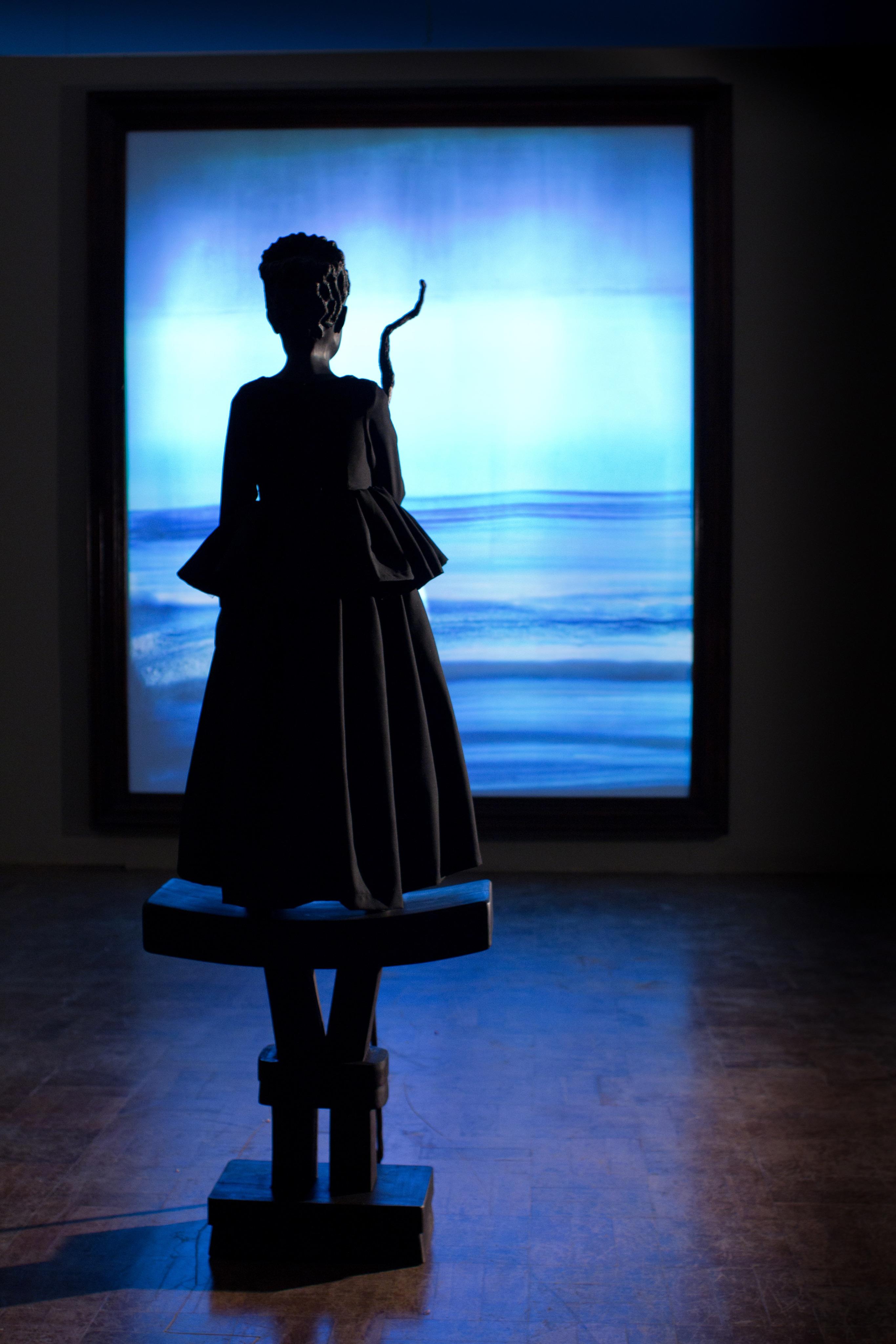
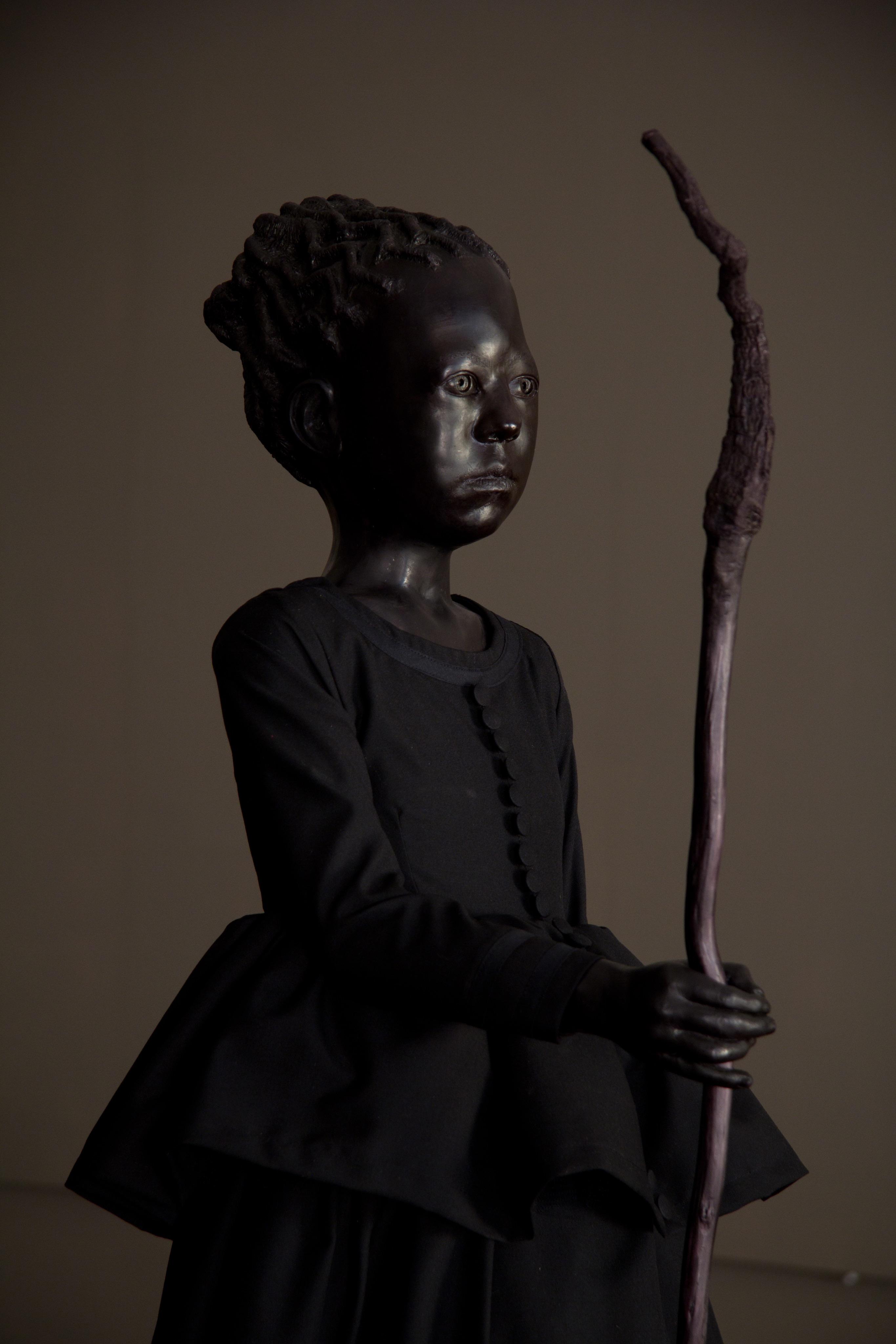
7
The Observer
In Dixie’s To Be King (2014), the observer is ‘The Black Infanta’ who stands on an enlarged headrest, a place to rest your head while dreaming. She holds a willow stick in front of her, the root of which is above the surface of the earth, inverted. The ‘Black Infanta’ is a black sculpture, reminiscent of an embodied shadow, and the viewer can only see the ‘Black Infanta’ from the light cast by the video projection in front of her. The Observer, however, observes both the ‘Black Infanta’ and the artwork. (Dixie 2014, p.1)
A bounty of questions arise when viewing the original mid-seventeenth century Spanish artwork, Las Meninas, as the work provokes much interpretation and debate beyond its immediate visual, superficial appearance. Some areas of contemplation are: Who is the observer? Am I the observer or am I being observed? Could the King and Queen be observing Velázquez painting? Has the Princess and her entourage come to observe Velázquez painting the King and Queen, who are reflected in the mirror on the wall behind Velázquez? Is Velázquez painting the Princess and her entourage while the King and Queen are the observers and reflected in the mirror behind Velázquez? Is the mirror reflecting the picture that Velázquez is painting? Here I offer my interpretation of the Black Infanta observing Dixie’s reinterpretation of the figures in Las Meninas (ibid)
I scored this piece for the following instruments: Soprano (To Be King 2 Melody), NASA recording of planet Neptune (EarthSky 2013), Absynth Synthesizer (‘Warped String Pulses’ reprogrammed), tambourine, foot stamp, harpsichord, harp, throat singer performing Nomaweza (DDC342-05), violin, three violas,5 five cellos and a double bass.
The Observer’s piece is 3ʹ06″ long. The first thirty six seconds are written in simple duple with a metronome marking of 60 crochet beats per minute. From 0ʹ36″ to 02ʹ43″, the metrical fluidity so often associated with Xhosa music-making surfaces, as the music alternates between simple triple and simple duple, finally becoming more fixed when the Xhosa throat singer adds to the texture at 2ʹ45″. This metrical fluidity surfaces again briefly from 2ʹ56″ as the music embraces simple quadruple returning to simple duple at 3ʹ04″ for the transition into the next piece
Throat singing, a technique known as Umngqokolo, is a form of overtone singing practiced in the Lumko5 district, Eastern Cape Province. (Dargie 1985)
8
The work opens with the Absynth synthesizer and a soprano soloist accompanied by the cello, viola and harpsichord. This is the same vocal fragment used during the opening of To Be King. After a short while, they are joined by the throat singer whose rendition is based on the Xhosa hexatonic scale (E, F♯, G♯, A♯, B, C♯). The throat singer sings a two bar pattern that consists of five beats. From these two bars I created a loop that is repeated six times, with half of the loop serving as a prelude to the throat singer’s part and the remaining half of the loop appearing as a postlude. At this point the metronome setting is altered to 65 crotchet beats in a minute as I determined this to be the exact tempo used by the throat singer, and to preserve authenticity I did not time-stretch the audio.
I chose to orchestrate the section using notes based on two major chords spaced a lower fifth apart, E major and A major. In choosing two major chords I bore in mind that traditional Xhosa music based on the Xhosa hexatonic scale uses two adjacent major triads, in this instance E-G♯-B and F♯-A♯-C♯. In my harmonization four notes from the Xhosa hexatonic scale are used: E, G♯, B and C♯, with use of the E and A major triads providing a mix of African and Western heritages. Here, the A major chord adds a more Western-sounding accompaniment to the Xhosa harmonic structure. Initially, the throat singer is accompanied by two cellos, with their parts structured in isorhythms with one of the cello’s playing a quaver triplet pattern and the other playing a pattern that starts on every 6th quaver repeating at the start of every 3/4 bar. This rhythmic interplay is suggestive of the polyrhythmic structure typical of traditional Xhosa music, and links with the African element in Dixie’s art work.
The sonic imagery drawn from the recording of Neptune is introduced at 0ʹ43″ and appears intermittently until 2ʹ50″. From 1ʹ44″, the string accompaniment is joined by a motif that represents the Princess figure. Later during this work the Princess motif is heard from 11ʹ33″ played by a nylon stringed guitar, and then from 12ʹ01″ by a viola with a cello version starting from 12ʹ04″. At this juncture, the repeated F note located in the Princess motif is transposed up by three semitones to G♯, and as music software permits, copied onto the Observer piece, retaining the exact note spacing and timing as it appears in the Princess section.
Intercultural integration appears from 1ʹ57″ to 3ʹ00″, where Western stringed instruments (harp, violin, violas and double bass) are each scored to play descending melodic patterns
9
based on the harmonics of the Xhosa hexatonic scale. Each instrument plays according to a different rhythmic pattern, and the combination of these varied melodies and rhythms combine to create an overall melodic and rhythmic structure. Adding to the intercultural texture one of the violas plays a response to the call of the violin, while percussive accompaniment is added by a Spanish fluted tambourine and a recorded African foot stamp.
10
Diego Velázquez
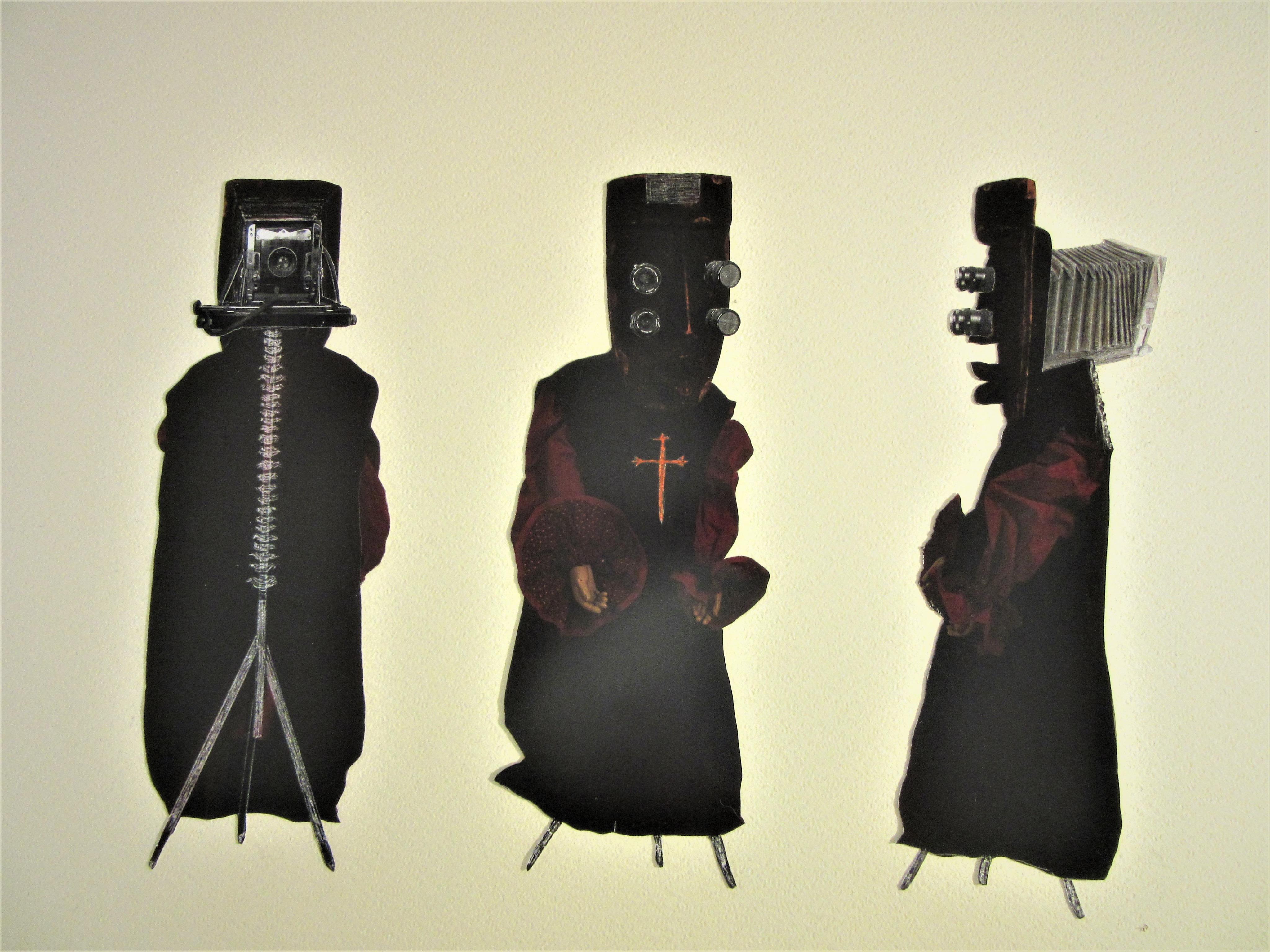
Velázquez
 Velázquez
Velázquez
11
Figure 3
It was one of Velázquez’s main ambitions to become a Knight of Santiago, which he attained three years after he completed Las Meninas in 1659. The Christian cross was painted onto his chest in the painting some years later. The Order of Santiago is a religious and military order of knights whose initial objective was to defend Christendom. It was founded in the 12th century in Spain. (Knighthood Information Centre 2012) Velázquez has the Santiago Cross painted on his chest in both the original work and in Dixie’s reinterpretation.
In Dixie’s reinterpretation, Velázquez has four lenses for eyes with a camera as the back of his head. He has a 360 degree view of the world, and is represented by a camera that records the event as a cameraman would. His artificial spine forms part of the tripod for his multi-lensed camera head, which forms part of portraying an individual that is once a combination of machine, human, African and mask.
I scored this piece for the following instruments:
NASA recording of the planet Saturn (EarthSky 2013), choir performing Intsinbi kaNtsikana (MOA18-01), organ, french horn, tubular bell, harpsichord, violin, two violas, five cellos and a double bass.
For my piece on Velázquez, I chose to use a hymn, Intsinbi kaNtsikana, composed by Ntsikana Ka Gaba (1780-1820) who is “still remembered as [the] one who laid a firm foundation for an African form of Christianity.” (Kumalo 2014:1) This example of early African choralism includes aspects of Victorian hymn writing, such as metrical regularity, and merges musical features located in Western and African cultures. A Xhosa monarch, belonging to the Xhosa royal line, Ntsikana was purportedly the first Xhosa person to be converted to Christianity, and his stature as a Christian prophet is still remembered and held in high regard. Given the Spanish court setting of Las Meninas (Velázquez) and Dixie’s reinterpretation, the inclusion of Ntsikana’s hymn is important in linking the Western and African cultures. Later in this work, in line with the overriding intercultural substance of the art work and this musical realization, reference to Ntsikana’s hymn undergoes transformation as it morphs into a waltz. This merging of African Traditional Religion and Christianity, which became known as African Christianity, was based on Ntsikana’s political consciousness whereby Western Christianity would not dominate African religion, but be incorporated into it. (Kumalo 2014)
12
Much metrical and tempo fluidity marks this portrayal, all reminiscent of African musicmaking. A waltz in the Western mould surfaces at 4ʹ54″. The hymn by Ntsikana is performed in compound duple, and appears here against a simple duple background showcasing the cross-rhythmic structure of much Xhosa music. A transition to the left Hip Hop Handmaiden begins at 5ʹ56″.
This section opens using a recording of Saturn, followed shortly by the hymn, Intsinbi kaNtsikana, accompanied by an organ playing in the style of 13th century organum representing Western church tradition as well as the Santiago Cross. The hymn by Ntsikana is based on the Xhosa hexatonic scale: F♯, G♯, A♯, B♯, C♯, D♯. Reminiscent of the “all seeing eye” a duplicate of the recorded audio is played alongside the original recording serving both as an echo and a structural overlay with the “eye” observing everything in different time-zones similar to the all-seeing Christian God.
At 4ʹ48″, a cello introduces a five note figure drawn from the Observer piece. This figure, a combination of even and triplet quavers, constantly shifts its starting position in the bar.
Structured in the irregular time signature of 5/4 it sounds simultaneously with the waltz’s 3/4 meter. The 5/4 figure injects an African style motif as it overlays the Viennese type waltz which typifies the refined elegance of aristocratic regal European lifestyles. This motif drawn from The Observer, suggests that Velázquez might also be an observer.
A four bar section of the choir that supports the lead male vocal in the hymn, has been time stretched so that the choir is able to sing in time to the waltz. The juxtaposition of6 waltz and tubular bells are used at various junctures – as they are throughout the work –with the tubular bells alluding to bell-ringing and Christian worship.
At the end of the piece, the bells signal in the start of the Hip-Hop Handmaiden piece. They are a fitting transition as we leave the church and step into the world of hip-hop with its religious paraphernalia and here in particular, a song performed by a deceased artist.
Time stretching allows one to change the length and tempo of the selected audio without affecting the pitch
and is available on music editing software.
6
13
Maria Agustina Sarmiento de Sotomayor
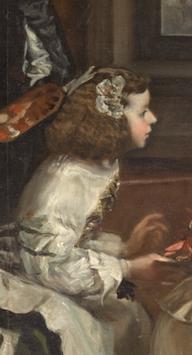
The Hip Hop Handmaiden
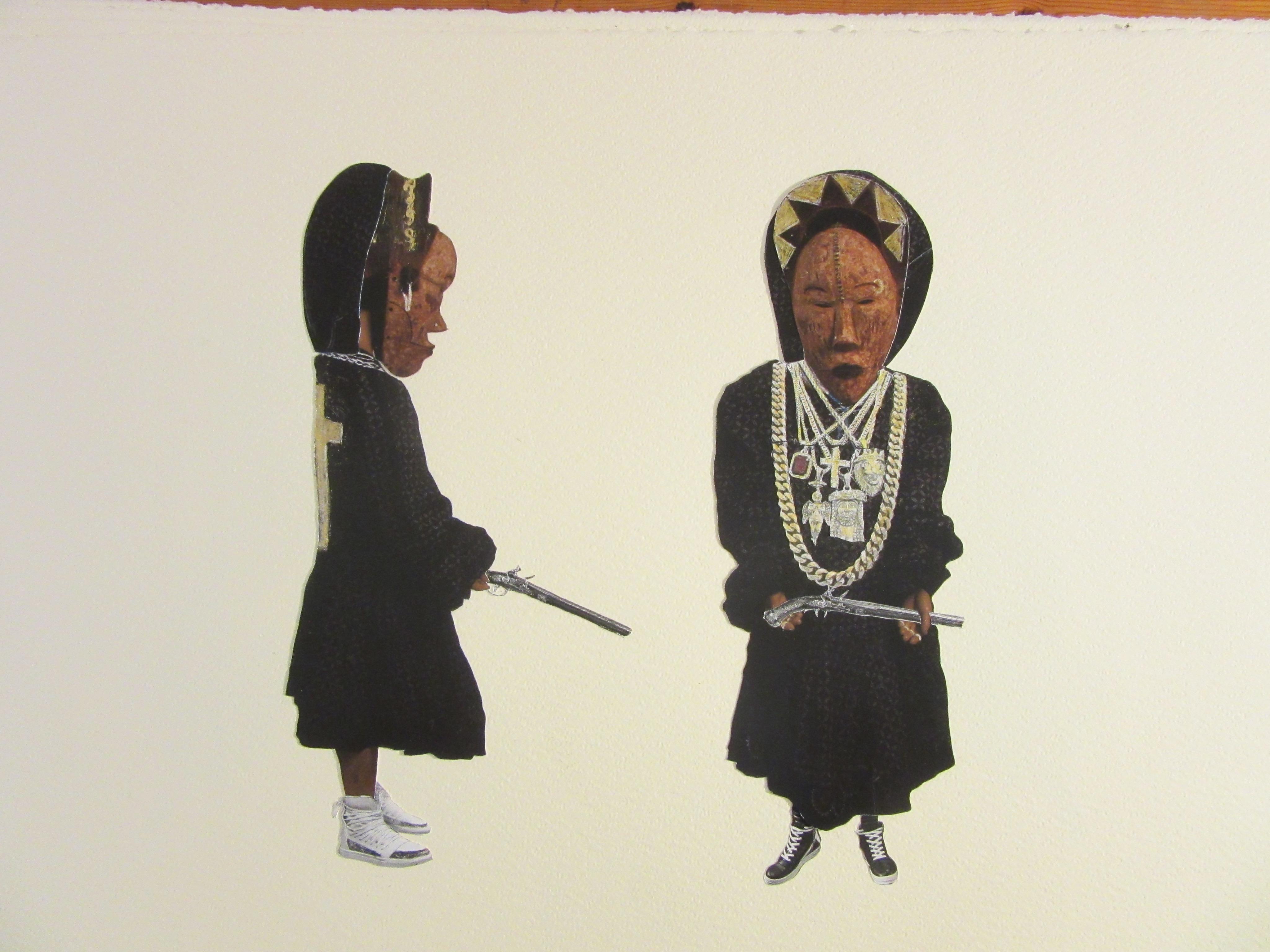
14 Figure 4
The Hip Hop Handmaiden
On each side of the princess are two meninas, two handmaidens from Nobel families. Maria de Sotomayor was the daughter of the Count of Salvatierra and the heir of the Duchy of Abrantez. In Dixie’s interpretation, she wears a white spirit maiden mask which represents a female guardian spirit in the initiation of young girls, funerary rites, ancestor cults and also in dances during a full moon. (African Masks n.d.)
This handmaiden is dressed as a hip hop artist wearing stereotypical hip hop jewelry, that resembles religious paraphernalia and suggests a strong connection to Christendom. A hip hop artist spreads the Word and attempts to put forward world views much like a person of religion. Missionary zeal can be compared to the desire to convert an audience to a particular world view. In colonial times, the local populace often considered missionaries to represent a double-edged sword frequently expressed as “they came to us carrying a Bible in one hand and a gun in the other.” Dixie’s figure suggests a connection between hip hop, religion and missionaries, and combines the visual clues together. A hip hop artist is also an observer, observing and commenting on social behaviors and situations of those around them.
Siyanda Futhu-Futhu (1985-2018) was a kwaito artist who grew up and lived in Grahamstown, the town where I have lived and worked for my entire adult life. I met him in 2004 when he approached me to arrange an instrumental accompaniment for a kwaito song he had written. He was vibrant and possessed a natural talent for rhyming and scansion, and while I mentored him in the first few years, he soon became the most popular artist in the greater Grahamstown (known as Makana) area and in 2010 won the Cacadu District Municipality Artist of the Year award. Siyanda was my friend and I present the second last recording I made with him to represent the Hip Hop Handmaiden.
I first arranged kwaito music in the late 1990’s when it had a very particular rhythm in the7 percussion arrangement. I have included that rhythm in this hip hop arrangement of Siyanda’s song to make the piece authentically South African.
The lyrics of the kwaito song are frivolous. The message of the chorus section is that Siyanda and his friends would like to be left alone to party and not be bothered by an
Kwaito is a South African music genre that combines elements of both hip hop and house music. Kwaito,7 usually in a faster tempo than hip hop, has similarities that include the use of looped samples and lyrical rhyming.
15
inebriated party goer. It was an unusual song for Siyanda in that it does not contain a deep message or any social commentary. It seems to simply exist as a reason for combining rhythmic words together.
I orchestrated this piece using the following instruments: Soprano (To Be King 2 Melody), NASA recording of Venus (EarthSky 2013) throat singer performing Shiy’ abantwana belila (DCC341-06), hip hop vocalist, bass drum, triangle, kwaito drums, kick, snare, synthetic clap, shaker, dununba , kenkeni , and djembe hand8 9 10 drums, kora , church organ, viola, five cellos and a double bass. I wanted to combine11 classical instruments, Xhosa music, Church music and modern day drumming for the hip hop handmaiden. I decided to use drum sounds from West Africa to refer to the West African mask the Hip Hop Handmaiden is wearing, and I added a kick, snare, shaker and clap from current hip hop and kwaito music.
The hip hop piece is set to a tempo of 93.5 crotchet beats per minute. I used an eight bar section from the throat singer’s recording which I looped and time-warped so that it could accompany Siyanda at this tempo. The throat singer uses the hexatonic scale: G♯, A♯, B♯, Cx, D♯, F, which is one tone higher than the Velázquez piece. Modulation to the new scalar region is effected by the church organ.
The piece opens with the sound of planet Venus followed shortly by the soprano soloist singing the same melody, To Be King 2 Melody, as that found in the Observer’s piece. The hip hop vocal starts in 6ʹ20″ and continues until 6ʹ52″, accompanied by the soprano, planet Venus and the bass drum. The organ starts in 6ʹ41″ and plays an eight bar phrase based on the notes of the hexatonic scale used by the throat singer. The organ adds a religious timbre to the hip hop and continues to play in the style of church organum. The organ accompanies the hip hop vocal in a manner that is typical of local hip hop music, as a theme to accompany certain sections of the lyrics. Local hip hop music is often based on four or eight bar instrumental loops, which are largely generated by loop based software. This results in very obvious sections in the accompaniment. At 7ʹ01″, a throat singer
Dununba drums are bass drums stringed with two cow skins originating from west Africa. (Reynders 2008)
Kenkeni drums are a smaller version of dundunba drums, See footnote 7.
Djembe drums are rope-tuned skin-covered drums played with bare hands from West Africa. (Enigmasa
2015)
A kora is a 21 stringed harp lute of West Africa. (Kaypacha 2019)
8
9
10
11 16
enters singing an eight bar time-warped loop. The throat singer, like the organ, accompanies the hip hop vocal in relevant sections.
The dununba, kenkeni, and djembe drums of West Africa begin in 7ʹ08″. They accompany the vocal in the same sectional manner as the organ and the throat singer.
At 7ʹ07″, the cello starts playing a motif that has been shifted up in pitch from the Observer piece where it was played from 1ʹ50″ up until 3ʹ18″ by a violin. This motif is one bar long and plays every eight bars starting always on the second beat of the bar. A kora plays the same part but as an echo, starting a semiquaver later.
The shaker, playing an eight bar percussion pattern also plays from 7ʹ06″. The shaker plays a very even pattern, over the kick drum of the kwaito drum pattern. Shakers are often attached to the ankles of the performers and here the shaker behaves as an ankle worn shaker, mimicking a regular foot stamp.
Three cellos join the accompaniment at 7ʹ32″. They alternate playing the tonic chords of the two chords that comprise the hexatonic scale (G♯, B♯, D♯ and A♯ Cx, E♯) and play an eight bar loop. From 8ʹ45″, a viola plays a four bar motif based on the organ part that is heard from 6ʹ40″. String instruments are commonly used in the arrangements of local Hip Hop music, typically playing in repeated four or eight bar loops. The organ, viola and throat singer serve as a transition to The Princess piece which uses the same throat singer. The throat singer exits the looped audio and performs from 9ʹ45″ to 11ʹ02″ during this transition .
17
Infanta Margarita Theresa of Spain

The Princess
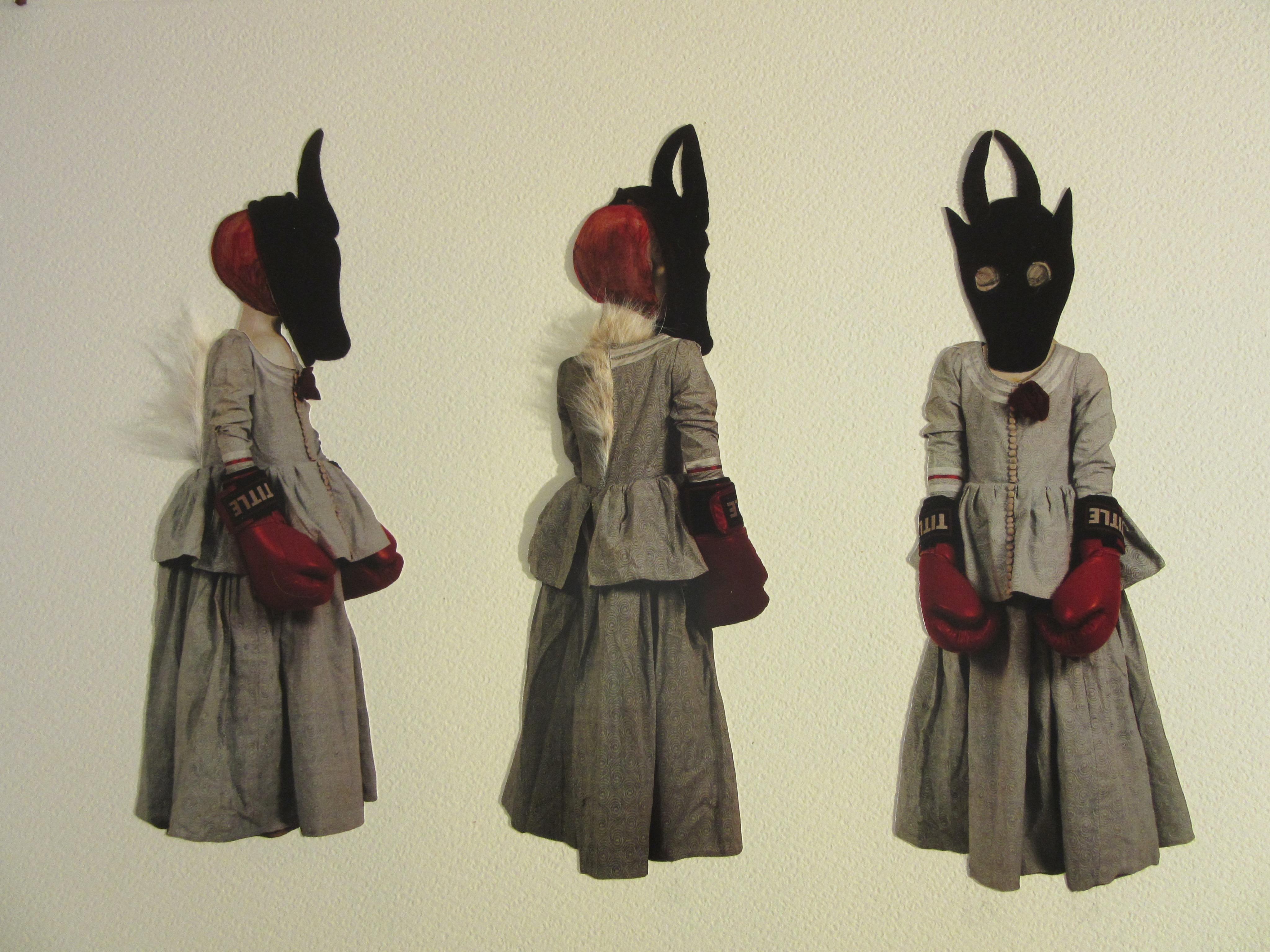
18 Figure 5
The Princess
Margarita Theresa of Spain was born on 12 July 1651 and was the daughter of King Philip IV of Spain. The marriage of her parents had been for political reasons, and she herself was betrothed to Leopold I, the Holy Roman Emperor. Margarita married Leopold in December 1666 when she was 15 years old. She died in March 1673 at the age of 21, having given birth to four children and having suffered two further miscarriages.
In Dixie’s reinterpretation, she wears a cow mask, and is an offertory sacrifice. She wears boxing gloves as if to resist the idea of herself being offered as a sacrifice. Subject to marriage rights and lobola (further denigration of her individuality as person) she also12 has an animal side, as cow hair can be seen coming out of her back.
The piece is orchestrated for the following instruments: NASA recording of the sun (EarthSky 2013), throat singer performing Shiy’ abantwana belila (DCC341-06), timpani, tam-tam drum, tubular bell, djembe, dununba, nylon guitar, nylon guitar, bass drum, two violins, two violas, organ, cello, two harps, celeste, Kontakt synth pad (‘Lesotho’) and double bass. Several of the Western classical instruments are used as plucked bow instruments and they are accompanied by other Western instruments playing in a more Western orchestral style, while the African drums, djembe and dundunba are juxtaposed with Western classical percussion, timpani, tam tam and tubular bells. The piece merges Western and African styles and instruments as The Princess’s experience is not culture bound.
The piece runs from 10ʹ15″ to 13ʹ57″ and undergoes four different tempo changes. The motifs and arrangements of instruments of this piece are based on the throat singer’s harmonics and melody, and the piece slowly speeds up to the speed that the singer intended it to be.
The throat singer continues to sing from The Hip Hop Handmaiden piece into The Princess piece and from 11ʹ03″, a new loop is introduced. This new loop is made from the voices Lobola is an African practice that involves providing payment, either in cash or heads of cattle, from the
prospective groom’s family to the parents of the prospective bride for customary marriage. (Alexander Forbes 2018)
12
19
of singers that accompany the throat singer, who can now be heard softly in the background. This loop plays continuously through The Princess piece.
Simple triple is introduced from 10ʹ35″. When I began composing the individual parts for this piece, while listening closely to the throat singer, I noticed that each time I reapproached the piece, I heard different melodies and rhythmic structures emerging. One day what I heard characterized a waltz and as I had scored it initially to run with a 3/4 bar, followed by a 4/4 bar and then a 2/4 bar, I felt inspired to find this change in emphasis. I composed the accompaniment in 3/4 as a fitting tribute to a Princess residing in a palace.
The throat singer uses the hexatonic scale G♯, A♯, B♯, Cx, D♯ and E♯, though the Western leading note F was added to allude to a more Western tonality. From 9ʹ55″ to 13ʹ09″, the synthesizer pad plays a constant F note against an alternating A♯ and G♯ The celeste plays a simple waltz melody based on the hexatonic scale from 10ʹ15″ to 12ʹ34″. From 10ʹ49″, a nylon stringed guitar and a viola, playing identical notes, accompany the celeste with a contrasting melody, using a quadruple time signature. The double bass also plays from this bar and continues through until bar 13ʹ30″, playing an ostinato pattern based on G♯ and A♯. The sum total of this sonic experience resembles traditional Xhosa musicking. All the above mentioned parts play repeated motifs, constructed using descending note patterns, another allusion to the traditional music of the Xhosa people. From 10ʹ15″ to 13ʹ44″, a dununba drum plays on the first beat of every bar.
These instruments are joined at 11ʹ29″ by a different nylon stringed guitar, playing The Princess theme. This theme is characterised by three repeated notes that lead to a descending pattern containing five notes and is repeated with the three repeated notes, playing over the last of the five descending notes. The notes of the first pattern are F, D, C, A♯, G♯, and F (derived from the Xhosa hexatonic scale) and in the repeat of this pattern, the G♯ is changed to a Fx, the leading note.
From 11ʹ52″ to 13ʹ11″, two djembe drums play a repeated pattern that lasts for two beats and plays every 13 beats. This is the start of a change in tempo as the piece moves towards the Bridal Chorus and a sense impending doom. The African drums assist with this transition and play alongside Western percussion, a combining of two cultures with similar traditions. From 11ʹ57″ to 13ʹ16″, a violin plays a four bar motif that is a variation
20
of The Princess theme and a cello plays The Princess theme until 14ʹ43″ Tam tam drums play from 12ʹ10″ to 13ʹ05″, striking once every four bars. They are accompanied by a tubular bell, which plays every two bars from 12ʹ10″. Both of these percussion instruments are added to give sonority and ceremony to the piece as well as a sense of impending doom.
From 12ʹ34″, the organ slowly plays the main theme from the Bridal Chorus (1850) from Lohengrin by Richard Wagner over eight bars, which is repeated four times. The Bridal Chorus (easily identifiable by modern-day Westerners as music associated with the wedding ceremony) represents the cow mask and the forced marriage that Margarita had to endure. From 13ʹ15″ to 13ʹ44″, different instruments stop playing at different times until by 13ʹ39″, only the throat singer and the sound of the sun remain as a transition to the Plague Doctor piece. The wedding is over, and a new, yet very different life awaits The Princess, one that ultimately leads to her death.
21
The Plague Doctor

 Isabel de Velasco
Isabel de Velasco
22 Figure 6
The Plague Doctor
The handmaiden on the right of the princess, Isabel de Velasco was the daughter of the King’s squire and her mother was lady-in-waiting to the Queen. She is depicted in Dixie’s reinterpretation wearing the mask of a Venetian plague doctor over an African mask, a mask over a mask. Attached to her mask and her waist are medical instruments.
In Dixie’s reinterpretation, she, like the other handmaiden, wears a white spirit maiden mask, the African mask. The white spirit maiden is a conduit between the earth realm and the spirit world (realm), channeling spirits. Three extensive plagues ravaged Spain during the seventeenth century and plague doctors were present at the time of death, with Dixie’s reinterpretation drawing on this fact as the figure explores the rites and ritual around death in Spanish and African contexts. She stands as a conduit between life and death. There are harbingers of death on either side of the Princess. The Plague Doctor wears the Santiago Cross on her mask.
The piece is orchestrated for the following instruments: NASA recording of Mercury (EarthSky 2013), uhadi bow player performing Inkulu into ezakwenzeka (TR013-06), two trumpets, castanets, tubular bells, bass drum, djembe drum, bass guitar, Retrologue synthesizer (‘Old Chap’), mute guitar, Absynth synthesizer (‘A Tines to Harmony’), kora, celeste, accordion, organ, electric piano and cello. The orchestration combines a light hearted folk dance with the typical instruments associated with death: trumpets, bells and organ. The modern club music sound is largely constructed using classical orchestral instruments, something that alludes to death as a timeless phenomenon.
This piece is set in simple quadruple time with a metronome indication of a crochet equals 126, and is set at the quickest tempo used in the work thus far. As the piece represents a dance of death I used a bow song which contains the words ‘Something bad is about to happen’, a song that has a very distinctive 4 bar rhythmic pattern that is played on the bow between the singing. The actual tempo of the song is used, and I looped the four bars played on the bow almost through the entire piece. In the process a few of the notes were moved in the audio loop so that they sounded perfectly in sync with a metronome, though I was careful not to alter the intended the tuning of the player.
23
The hexatonic major scale that the bow singer uses is B, C♯, D♯, E, F♯, G♯ and the timing of the shifts between B major and C♯ minor key centers were a deciding factor in choosing this particular song to use here. I wanted to compose a dance of impending death that crossed over between traditional Xhosa music and 21st century club dance Music, but yet contained mostly instruments of 17th century Italy and Spain.
The piece opens at 13ʹ57″ with a traditional Italian-styled tarantella, which is a folk dance that was traditionally used to cure the dancer of the symptoms of a tarantula bite. A celeste, alluding to the childlike innocence of the handmaiden, herself a 10 year old child at the time of the painting and having to support the five year old Princess, and an accordion, an instrument associated with Italian folk dances, are used. The celeste plays in a call and response manner alongside the accordion, which also adds a playful aspect to the dance. The bow player’s singing is layered over that of the tarantella music showing the cultural duality in Dixie’s work. Tubular bells add an ominous timbre, that of death and religious solemnness. These instruments are accompanied by castanets which add Spanish flavour to the rhythmic percussion. An organ plays from 14ʹ30″ to 16ʹ07″ using only notes of the hexatonic scale, and accompanies a trumpet that plays a slight variation of the Last Post. Playing descending melodic lines similar in structure to Xhosa13 traditional melodic lines the organ part stands in contrast to the trumpet part which plays mainly rising melodic lines.
A bass drum plays from 14ʹ29″ to 17ʹ54″ under the trumpet and organ. It does not play14 at regular intervals, and adds a sombre sense to the piece. Absynth, playing a preset, A Tines to Harmony, enters at 14ʹ10″ and plays two sections until 16ʹ05″, adding to the texture’s complexity. From 15ʹ21″, a muted guitar plays a repeated triplet pattern and is a joined at 15ʹ29″ by an electric piano playing a hemi-demi-semiquaver pattern, characteristic of club dance music. From 15ʹ37″ to 16ʹ52″, and from 17ʹ08″ to 17ʹ23″, a Retrologue synthesizer provides the bass sound of a “heartbeat” pattern. Four bars later, it is joined by an electric piano that plays until 17ʹ33″, and a cello that plays until 17ʹ57″. The electric piano plays a typical 21st century-styled dance motif, while the cello echoes
The Last Post was used by the British military as a call to soldiers for duty as well as for funeral rites.13 (Fishel 2015)
Bass drums were used by army marching bands. In military and marching bands the bass drum has two14 heads, tensioned by rope lacings or metal rods, and it is struck on either head. (Cunningham n.d.)
24
the bow singer, using a pizzicato technique and accenting every fourth and seventh beat of the bar.
From 16ʹ03″, a kora begins to play a melody based on the bow player’s vocal part, deviating from the hexatonic major scale by including an E# (Xhosa hexatonic scale) in it’s the descending melodic line. A trumpet joins the kora and these two instruments alternate playing call and response melodic patterns with each other until 16ʹ56″. At 16ʹ53″, the Accordion reintroduces the tarantella dance. At 17ʹ01″, the celeste enters, echoing the tarantella melody, on top of an ostinato C# figure. The dance music rejoins the tarantella for a brief recapitulation of the death dance which begins to disintegrate as instruments gradually stop playing, one by one, until only the sounds of Mercury and the bow are heard; sonic death where only the sound of the universe and centuries-old traditional musicking remain.
This piece makes reference to a traditional death dance, but also refers to current day dance music that sometimes accompanies a culture of substance abuse and death , a15 clear parallel between the abuse that inhabited the seventeenth century Spanish royal house and modern-day issues of abuse.
Respondents who used illegal drugs were 2.5 times more likely to report that they prefer dance music.
Goa party visitors were nearly 5 times more likely to use illegal drugs. For those who reported visiting clubs, the odds of using illegal drugs were nearly 2 times higher. (Havere, Vanderplasschen, Lammertyn, Broekaert, Bellisn. 2011).
15
25
The Dwarf
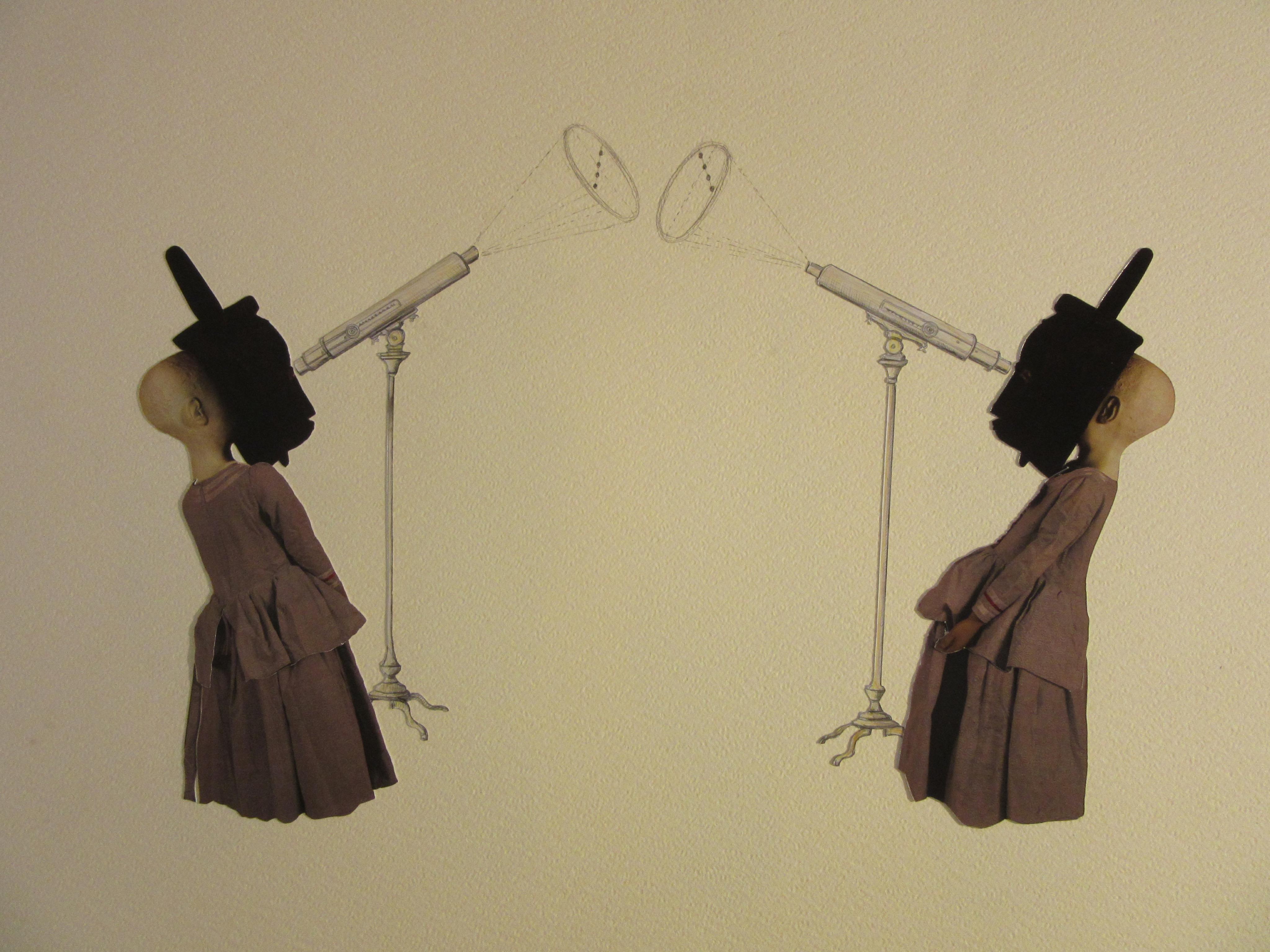
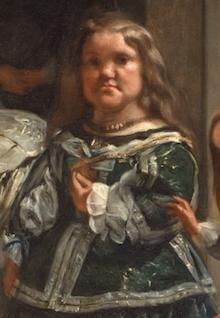
26
Mari Barbola
Figure 7
The Dwarf
The dwarf figure offsets the Princess. Dwarves were common in the courts of Europe during the sixteenth and seventeenth centuries and offered amusement and distraction for the royal class who considered all others to be beneath their dignity and not worthy of respect, especially those with visible deformities. Frequently, placed alongside royalty their diminished stature was used to contrast the height and arrogant power of the monarch. Dwarves were present in the court to be ridiculed and owned. (Ivanova 2013) In Las Meninas, Velázquez painted the dwarf, Mari Barbola, as a dignified person following his usual pattern of depicting dwarfs with considerable dignity. ‘They are portraits—that is, they affirm the integrity of the subject as an individual, worthy of a name, a psychological investigation, a portrait.’ (Siedell 2012)
Dixie places a beautifully crafted maiden mask on a dwarf figure who in the original scenario is not usually considered to be beautiful. In this reinterpretation, the dwarf has a telescope that allows her access to a world beyond the stage, she can see beyond it all into the world and the greater universe. Through the telescope she can view the planets and gains a different perspective of the society and the world. Interestingly, Las Meninas (Velázquez) is a large portrait measuring 3,205 meters by 2,815 meters (Prado Museum 2019) and demonstrates the King’s status in that he was able to commission and own this expensive art work. However, all earthly political thinking of the Princess or King’s status, takes on a different perspective for the dwarf as she gazes on the planets.
The piece is orchestrated for the following instruments: soprano (To Be King 2 Melody), NASA recordings of Earth, Neptune, Saturn, Venus, Mercury, Mars, Jupiter, Sun and Moon (EarthSky 2013), throat singer performing Nomaweza (DDC342-05), uhadi bow player (TR013-08), umakhweyana bow player16 performing Akasa ngi baleli (MOA18-09), umrhubhe bow player and singers performing17 Kwa dilika (DDC247-05) two tenors, piccolo, trumpet, xylophone, tubular bell, Reaktor synthesizer, theatre organ, Native Instruments (‘Kinetic metal’), kora, celeste, accordion, violin, three violas and two cellos.
A Zulu musical bow using a gourd as a resonator, and having a split string.
Umrhubhe bow is an instrument of simple construction: a small wooden bow, strung most often with brass
wire. Umrhubhe bow is played by friction – rubbing the string with a reed or scraped stick, and using the mouth as a resonator. (Dargie 2011, p.34)
16
17
27
The piece starts at 18ʹ01″ with a short transition, sung by the soprano singing the same melody that opens both this work, in The Observer piece, and also To Be King. It is also present in The Princess piece, and serves as a unifying element across both works, as an observer. The time signature is simple quadruple time and the metronome tempo is set as a crochet equaling 92 beats per minute with the “circus” accompaniment that plays from 18ʹ40″, being the determining factor in choosing this tempo.
Running the entire length of the piece is the sound of the planet Earth, with the sounds of all the planets used in this work, starting at 18ʹ38″ and running in order of their associated characters, as if the Dwarf were scanning her “new” world, the universe, from left to right. The planet sounds are completed at 22ʹ50″. Occasionally, from bar 18ʹ40″ to 20ʹ28″, I used a Kontakt 5 instrument called ‘Kinetic Metal’ and a Kontakt 5 instrument called ‘Theatre Organ’ (19ʹ07″ to 19ʹ36″) to generate a warped Harmonium sound and 1920‘s Silent Movie accompaniment to conjure up a picture of the dwarf as a side show, something to be displayed. This view of dwarfism is overlaid in the piece with moments and motifs from all the other figures in Dixie’s reinterpretation and the piece develops into the dwarf’s new perspective of her world, a perspective that places her beyond those around her.
From 18ʹ24″ to 20ʹ40″, the organs are accompanied by a bow player (TR013-08) that is used in a later piece for the Midget. From 18ʹ53″ to 21ʹ20″, a different bow player (DDC247-05) can be heard quoting from the Midget piece. From 19ʹ09″ to 20ʹ34″ a xylophone plays the Princess theme. From 19ʹ20″ to 20ʹ52″, the tubular bells play the Princess theme inverted, showing the Princess in a deformed guise; a role reversal according with the Dwarf’s ever increasing appreciation of the wider universe. From 19ʹ38″ to 20ʹ33″ the trumpet plays The Last Post from The Plague Doctor piece possibly indicative of the Dwarf’s shedding of the limitations associated with physical challenges. From 20ʹ04″ to 20ʹ37″, the waltz theme from the Velázquez figure, played by the accordion, can be heard, accompanied from 20ʹ08″ to 20ʹ22″ by the celeste playing a typical waltz accompaniment as the Dwarf’s realization takes hold that she too is important in her own right, and as a person deserves the dignity accorded to the Princess.
Continuing with the theme linking royal privilege and dignity to gold gilded ballrooms a further reference to the Velázquez waltz is introduced: from 20ʹ19″ to 21ʹ10″ Cello 4 repeats the motif it played in The Observer piece, and which is also found in a strand that sounds as an accompaniment feature below the Velázquez waltz.
28
Numerous musical mentions to other members depicted in the portrait are heard in the ensuing concluding moments of this movement (piece) as the Dwarf’s realization takes hold that all people are important in the wider universe, not the perverse understanding perpetuated by the ruling royal class. Snatches of material from music already heard and yet to come is presented: The Plague Doctor, Charon, The Chaperone, The Bodyguard, Cerberus, The Princess, and Midget. It concludes with the viola playing the inverted Princess theme, just as a final reminder of the Dwarf’s newfound understanding of a different, more realistic, and just, world order.
29
No other image available

30
Nicolasito Pertusato
Figure 8
The Midget
Nicolasito Pertusato was rumoured to be the son of Mari Bárbola (Valles 2014). He appears sexually ambiguous in the painting with long hair and delicate clothing, and can be seen to have had some kind of a relationship with the dog. In Dixie’s reinterpretation, he is a child dressed as a hunter. South Africa’s First People, the San, were huntergatherers, and hunting has served as a means for food survival across millennia. Yet, the colonial explorers who “discovered” Africa were not primarily hunters for food sustenance, but also trophy hunters killing wildlife, thus disturbing the natural order. In another sense these hunters were hunting land and natural resources adding to colonial conquests. It is the sense of the hunter and hunted that is encapsulated in Dixie’s clothing of the Midget; at once, a hunted tormented figure seeking solace in a household pet, and yet still fighting to maintain a place in an unequal hierarchy.
The piece is orchestrated using the following instruments: NASA recording of earth’s moon (EarthSky 2013), throat singers performing Shiy' abantwana belila (DDC341-06), uhadi bow players performing Ndazenza udalala uegxagxa (TR013-08), uhadi bow player performing Kwa dilika (DDC247-05), foot stamp, Xhosa singer performing Tula mtwana (TR0022-04), Xhosa dialogue, piccolo, two French horns, tambourine, shaker, steel stringed guitar, kora, accordion and cello. The guitar, tambourine and accordion add traditional elements to the children’s song while the horns contribute a more serious contrast to the orchestration.
The Midget piece is set to a metronome tempo of a crochet equals 116 beats per minute to match the more upbeat tempo of the traditional Spanish children's song that I used, Quisiera Ser Tan Alto Como La Luna. The time signature 4/4 is used until during the children’s song, a 2/4 bar is needed every five bars from 23ʹ23″ to 24ʹ23″. The song has a five bar pattern with four bars using 4/4 time and one bar using 2/4 time. When the song finishes, 4/4 time is used until the end of the piece.
The piece opens at 22ʹ46″ with the sound of the moon and a baby’s cry. The cry was present on the recording of the Xhosa singer. The lullaby is based on the hexatonic scale of F♯, G♯, A♯, B#, C♯ and D♯ and is sung from 21ʹ45″ to 23ʹ12″. Fragments of the lullaby are heard at 23ʹ40″, 23ʹ45″ and again in 23ʹ49″. I prepared a two bar section of the lullaby that I placed at moments in the children’s song that harmonise with the song. These moments occur eight times from 23ʹ55″ to 24ʹ31″. The accompanying voices of a
31
throat singer (DDC341-06) also used in The Hip Hop Handmaiden, The Princess, The Dwarf and Cerberus pieces, starts here alongside the lullaby and appears intermittently to encourage the Midget; this shows the interrelatedness of the various movements (pieces) and the two representations of the art works.
The uhadi bow player (TR013-08) and another uhadi bow player (DDC247-05) are also heard from the start of the piece, with the bow singer humming to the lullaby while the bow player adds a scraping sound. This scraping sound will also be heard during The Dog piece. At 23ʹ17″, the well-known phrase ‘That’s one small step for man, one giant leap for mankind’ (Neil Armstrong 1969) can be heard by a woman speaking in isiXhosa.
A piccolo introduces the children’s song at 23ʹ23″, which is then accompanied by a guitar, kora, tambourine and the above mentioned bow player and singers. From 23ʹ20″, a foot stamp, a tambourine and a shaker add percussive elements to the song as does the sound of a strummed steel string guitar that enters at 23ʹ31″. From 23ʹ59″ two French horns play open fifths based on the hexatonic scale of the lullaby. Horns frequently accompanied hunts in colonial England and so here the Midget is announced as a hunter and accompanied by horns. From 24ʹ22″, a bass drum begins the transition between The Midget and Cerberus pieces.
32
The Dog
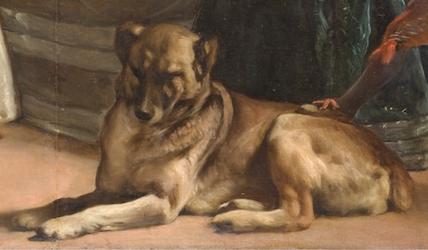
Cerberus
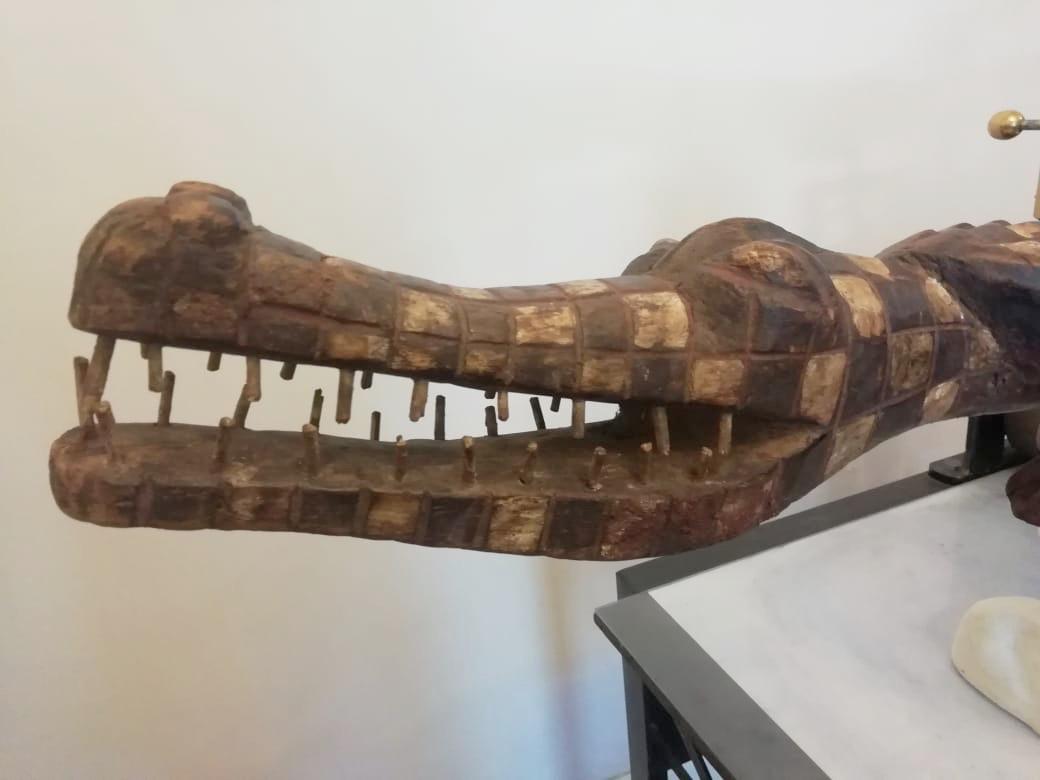
33 Figure 9
Velázquez places the dwarf and midget next to the dog, suggesting that they are closer to animals than to humans. In Dixie’s reinterpretation, the dog has three heads and is Cerberus, who guards the gates of Hades. His heads were said to represent the past, present and future. (Robison 2016) The planet Mars has a dark spot, an albedo, called Cerberus. (NASA 2005)
The piece is orchestrated for: NASA recording of Mars (EarthSky 2013), throat singer performing Shiy' abantwana belila (DDC341-06), umrhubhe player performing Akasa ngi baleli (MOA18-09), uhadi bow player performing Kwa dilika (DDC 247-05), Xhosa singer performing Tula mtwana (TR0022-04), piccolo, two French horns, trumpet, bass drum, Absynth synthesizer (‘Warped String Pulses’), organ, violin, two violas and cello.
This work contains music from the past, present and future. In both its style and orchestration this piece could be referred to as programme music. It represents the Midget going into battle against a fearsome three headed dog in a terrifying place. The use of some of the instruments is deliberate as they are often used in soundscapes to evoke impending conflict, such as, the low rhythmic cello theme used from 24ʹ52″ .
The time signature is simple quadruple time and the tempo is crochet equals 116. A piccolo plays Quisiera Ser Tan Alto Como, this time routed through The Mouth, a synthesizer created by Tim Exile that generates melodies and harmonies on audio signals. I used it to warp the sound of the piccolo and create a different melody that is still strongly based on the song. The warped piccolo plays until 25ʹ22″. The piccolo is accompanied by a two bar section of audio taken from the umrhubhe player (MOA18-09). This audio plays from 24ʹ40″ to 26ʹ29″ and is doubled from 25ʹ09″ to 26ʹ00″ where it starts two beats later than the original. The hexatonic scale that the bow singer uses is B, C♯, D♯, E♯, F♯, and G♯. From 24ʹ26″ , Absynth (‘Warped String Pulses’ reprogrammed) is introduced softly and initially plays underneath the Cerberus piece, and then from 26ʹ47″ to 28ʹ35″ , plays as a prominent instrument in the Charon piece. The trumpet plays a fox hunt call that alludes to the Last Post from 24ʹ40″ and plays until 26ʹ01″, using notes of the Midget’s hexatonic scale. A bass drum plays from 24ʹ22″ to 26ʹ08″ , marking time.
Cerberus
34
From 24ʹ40″ to 25ʹ39″, a violin and two violas, play chords based on the hexatonic scale used for The Midget piece and they are joined at 25ʹ06″ by the French horns, playing the same open fifth motif that they played in The Midget piece. The cello plays from 24ʹ51″ to 25ʹ41″ and mimics the umrhubhe player (MOA10-09). From 25ʹ35″ to 26ʹ33″, the same uhadi player from The Midget piece, can be heard. From 25ʹ55″ to 26ʹ45″, the Xhosa singer (TR0022-04) from The Midget piece can be heard as he emerges victorious.
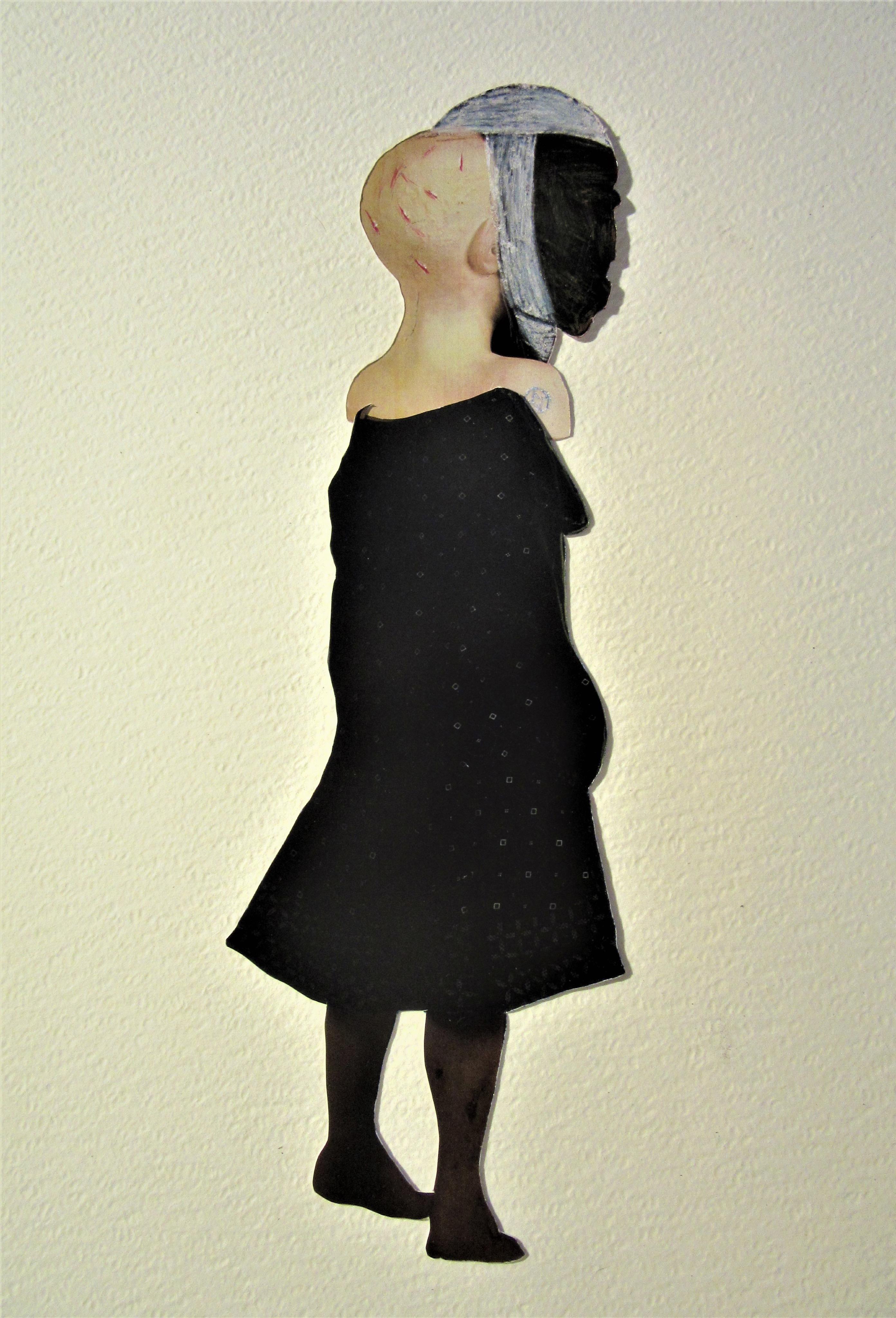
35
Jose Nieto Velázquez
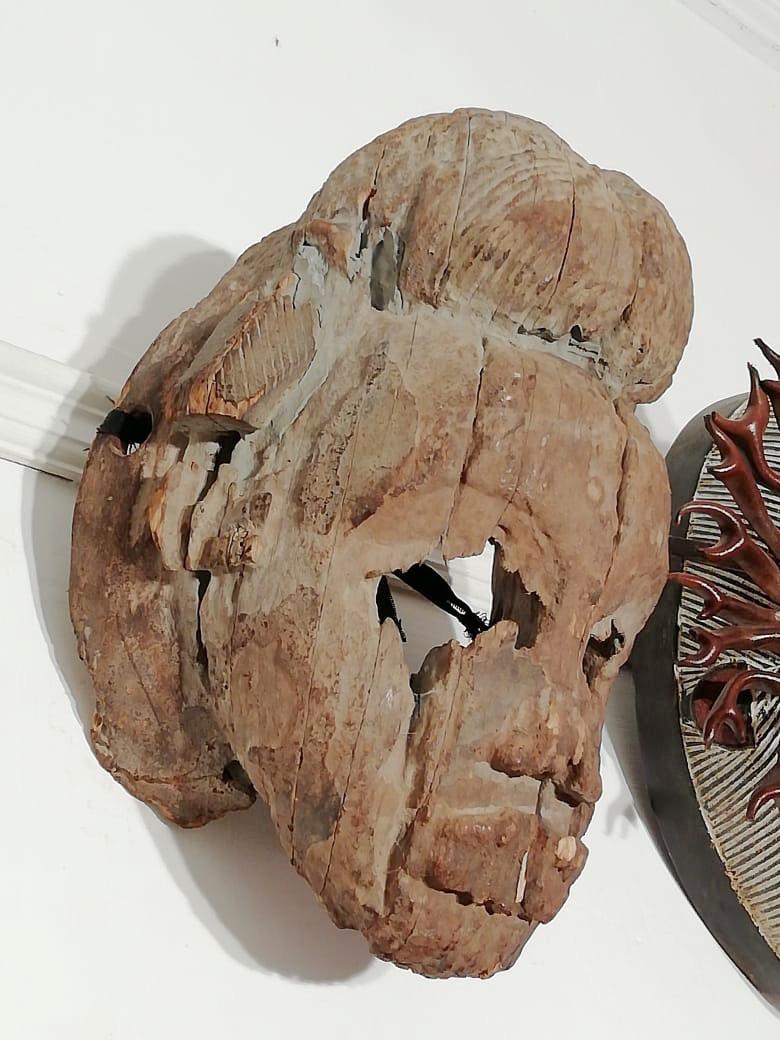
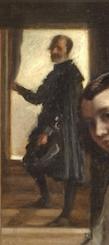 Charon
Charon
36 Figure 10
Charon
In Greek mythology, Charon is the Ferryman of Hades who transports the dead across the rivers Styx and Acheron (Theoi Greek Mythology 2018) In the painting, he is the court chamberlain and stands in the doorway, between the inside and the outside. In Dixie’s interpretation, Charon is between spaces, he takes from one space to another and is the bridge for crossing over between spaces. Styx was the goddess who lived at the entrance of Hades and personified the river that separated the world of the living from the underworld, the river that Charon traverses.
The piece is orchestrated with the following instruments: soprano (To Be King 3 Melody), NASA recording of the sun (EarthSky 2013), umakhweyana player performing Akasa ngi baleli (MOA18-09), Retrologue synthesizer (‘Old Chap’), Reaktor synthesizer (‘Spacedrone’), Reaktor synthesizer (‘Rounds’), Absynth synthesizer (‘Warped String Pulses’), Absynth synthesizer (‘Trace’), organ, electric piano and two cellos.
This piece is an electronic soundscape which suggests a dark and deathly, almost seductive dance: a female deity juxtaposed with the deathly ferryman carrying the dead across her fluid manifestation. It is she that Charon must traverse.
Set to a time signature of simple quadruple with the tempo aligned to 116 per minute this piece speeds up to 126 crochets per minute by 27ʹ06″. The soprano sings the To Be King 3 Melody which is routed through a reverb effect (reverb time of 6,7 seconds with a pre delay of 63ms), and a delay effect (using 1100 ms delay). The soprano audio is duplicated and the duplicate routed through The Mouth instrument where extra voices are generated that are not harmonically connected to the original. This combination of voices alludes to an under worldly siren.
The recording of the sun is reversed to serve as the background planet sound for Charon, a clichéd reference to the underworld being the opposite of the living world where in this work, the Princess has been allocated the recording of the sun. The bow player (MOA18-09) who played a large role in The Dog piece is used again here, this time with the audio loop reversed which adds an unusual other worldly sound. I reprogrammed the Absynth synthesizer preset ‘Warped String Pulses’, so that sonically it suggests the creaking of a boat moored to a riverside in a gloomy and eerie atmosphere. This sound
37
starts playing softly under the Cerberus piece and becomes more prominent during this piece; it can be heard throughout the piece.
An Absynth synthesizer (‘Trace’) preset is used from 27ʹ06″ to 28ʹ29″, to provide more unusual and eerie river type sounds. The electric piano (27ʹ18″ to 28ʹ44″), the cello (27ʹ50″ to 28ʹ51″) and the Retrologue synthesizer (27ʹ49″ to 28ʹ29″) motifs from The Plague Doctor piece are reintroduced here. These three motifs bring the death dance of The Plague Doctor piece to Charon, the merchant of the dead.
The reversed Sun sound is made into a bar long section of audio that contains four low notes. This section looped, provides a constant bass pulse on the notes C and C♯ and plays from 27ʹ44″ to 28ʹ28″. From 28ʹ17″ the organ reintroduces the opening of the Bridal Chorus (Wagner) from the Princess piece, alluding to the princess’s premature death. From 28ʹ40″, a cello plays the motif from To Be King (Dixie 2014) that signals the end of that work leading the process out of the Underworld and up toward the Light of the Chaperone who leads the listener to a more gracious space.
38
The Chaperone

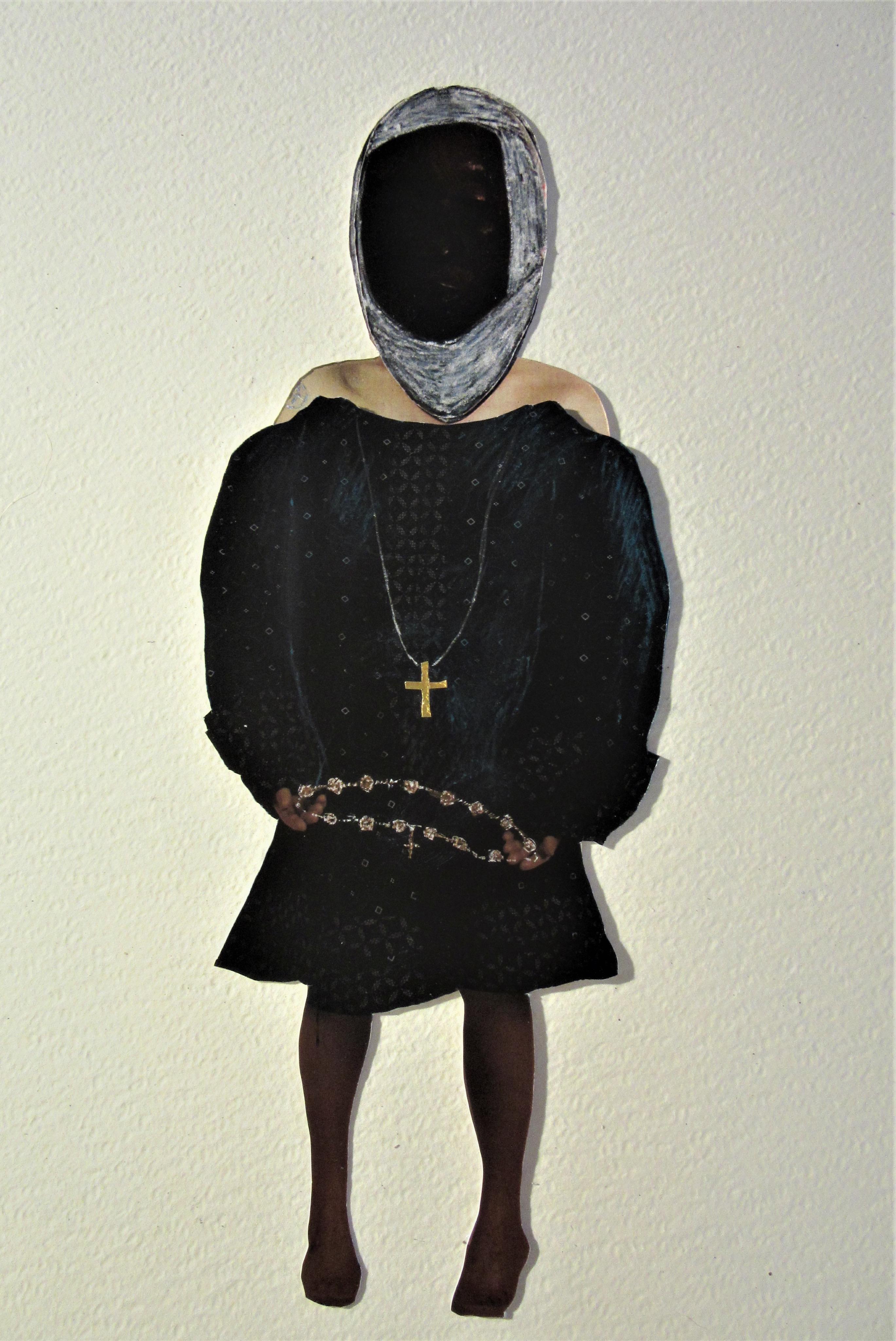
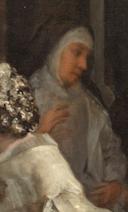 Marcela de Ulloa
Marcela de Ulloa
39 Figure 11
The Chaperone
In the painting the royal chaperone, wears mourning clothes and stands next to an unknown bodyguard towards whom she is leaning. She is the widow figure in the court. In Dixie’s work, she wears a male mask with nun-like clothing around her mask. While she has a cross and rosary beads in her hands, she has a shaven head, wears high heel shoes, and an off-shoulder dress. After WWII, thousands of women were humiliated by being publicly displayed with their heads shaven to show their suspected collaborations with German soldiers, and they were subjected to a “walk of shame”. (Beevor 2009) The chaperone is seen as a “virgin whore”.
The piece is orchestrated for: NASA recording of Jupiter (EarthSky 2013), steel stringed guitar, two nylon stringed guitars, kora, harpsichord, organ, two violins, viola, three cellos and double bass. I wanted to compose a very gracious piece of music for the disgraced chaperone figure, something that seeks to reaffirm her dignity. The style of a 17th century Folia with variations conjures up, for me, a gentle court lady of breeding. The use of guitars for one of the variations adds a Spanish element to the music, while the kora shows links to Africa.
Richard Hudson distinguishes between an early and later Folia and attributes the chord progression of the later Folia to Falconieri, who published a Folia in 1615. (2015) I used the basic chord progression of a later folia for this piece, in the key of D minor, which has been the most often used key for this style of composition. The chord progression I used is, d: i, V7, i, VII, III, VII, i, V7, i, V7, i, VII, III, VII, i, V7, i.
The metronome marking is crochet equals 89 in simple duple time. The Folia opens from 28ʹ57″ with the sound of Jupiter and ten bars of the looped and reversed sound of the sun from the Charon piece, which serve as a transition between the underworld and the lady of the court. The 16 bar announcement of the Folia is played by a harpsichord, organ, viola and cello.
From 29ʹ29″, a solo is played by a cello for the first eight bars of the first variation, accompanied by strings and harpsichord. This is followed at 29ʹ45″ by violins, viola, cellos and kora playing countermelodies in a call and response manner, typical of traditional Xhosa musicking.
40
The first eight bars of the second set of variations begin at 30ʹ01″ when two nylon stringed guitars play an accompanied duet, supported by a steel stringed guitar, typical of 17th century Spain, a harpsichord and double bass. From 30ʹ18″, two cellos, two nylon stringed guitars and a kora play variations accompanied by a steel stringed guitar.
From 30ʹ32″, the structure of the Folia is altered by a third set of variations. This set is used to modulate from D minor to C minor. At 30ʹ32″, the Princess motif, with its characteristic three repeated notes can be heard over the cellos, guitars and a new motif played by a cello using pizzicato technique. The Princess motif has been altered to fit the chord progression and the time signature of the Folia. The two cellos and the two guitars play the same variations as they played from 30ʹ18″ to 30ʹ32″, but now appear with the altered key signature. From 30ʹ47″, the cellos and the guitars, which began 30ʹ32″, on the second beat of the bar, now begin on the third beat of the bar, while the Princess motif repeats playing one beat early. This interrupts the 16 bar Folia pattern and adds rhythmic interest to the variation as it leads to the Bodyguard piece. The final bar of the Folia has a simple duple time signature to make up for the missing beats lost during the modulation section from 30ʹ47″
41
Unknown
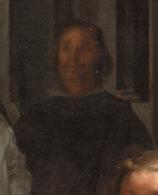

42 Figure 12
The Bodyguard
The Bodyguard in the painting is an unknown male. Dixie’s sculpture wears a female mask and a Spanish crusader helmet. The Bodyguard stands next to the chaperone and they have gender swopped masks. They also wear the same material that the King and Queen wear in To Be King (Dixie 2015). The Bodyguard wears a Mandela print shirt indicative of Mandela the “freedom fighter”. Here the Bodyguard has a gun.
The piece is orchestrated with the following instruments: NASA recording of Uranus (EarthSky 2013), three male vocalists performing a traditional song about Mandela, tam tam drum, harpsichord, organ, three violas, five cellos and double bass.
The song is sung in compound duple time against the simple quadruple time of the accompaniment and is set around the Xhosa hexatonic scale C, D, E, F♯, G, A.
Nine and a half bars serve as a transition between The Chaperone piece and the Mandela song (31ʹ03″ to 31ʹ30″). During these bars, fragments of Die Stem (Langenhoven 191818 and de Villiers 1921) and Nkosi Sikelel’ iAfrika (Sontonga 1897) playing simultaneously.19 The organ, harpsichord, two violas and a cello play the harmonic structure of Nkosi Sikelel’ iAfrika. The cello plays in a “struck bow” style while one of the violas plays a repeated triplet figure that continues through to the end of the Mandela song at 32ʹ06″. Two other cellos play fragments of Die Stem from 31ʹ03″ to 31ʹ32″. From 31ʹ09″ to 32ʹ39″, a viola plays the Princess motif at the identical speed and note spacing that it was played in The Princess piece. These two anthems represent two different worlds with differing underlying philosophies. But it is the philosophy underscored by Mandela that is victorious. From 31ʹ30″, three male vocalists, singing seven recorded parts, sing a traditional song praising Mandela. This song is sung by older women at traditional ceremonies while here it is sung by young men, gender swopping, as with the Bodyguard and Chaperone’s masks.
The anthem representing the Afrikaner nation which was introduced as the national anthem in 1938
alongside God Save the King. From 1957 to 1994, it was the sole national anthem of South Africa. In 1994, Nelson Mandela declared that Die Stem and Nkosi Sikelel’ Afrika would be the national anthems of South Africa. (flatinternational n.d.)
The anthem adopted by the ANC in 1925 and in 1994, accepted as one of two of South Africa’s national
anthems. (The Heritage Portal 2017)
18
19
43
A direct translation of the lyrics is as follows:
Lead vocalist: “Whose car is it that has turned around at the gate?”
Supporting Vocalists: “Mandela knows, Mandela knows, he’s the one in charge”.
The double bass plays on every crochet beat from 31ʹ39″ which is in contrast to the cello which plays a three bar figure that first accentuates the first two beats and the last quaver of the first bar, then the first two beats of the second bar, followed by the first, second and fourth beats and third and sixth quavers of the third bar. This figure imparts a fairly disjointed polyrhythmic feel to the song, which is somewhat resolved when the second verse starts at 31ʹ48″ where a cello repeats the same rhythmic part first played by the cello during the transition from 31ʹ03″. A viola and two cellos accompany the second verse, playing slow sustained notes.
Drawing the complete work to a close aspects of the earliest thematic incantations are revived. From 32ʹ14″, the soprano, sings the opening notes of the work (To be King 2 Melody). She is joined at 32ʹ22″ by the throat singer (DDC341-08) who also opened the work and on whose song the Observer piece is based. The male vocals gradually fade away from this point, and this is achieved through setting a large reverb to process their audio. The reverb send is set to prefade and thus, as they fade away, the reverb remains giving the impression of distance between them and the listener. The entire work ends at 32ʹ56″
44
To Be King
To be King is informed by the essay Las Meninas which Michel Foucault published in 1966 as the first chapter to his book The Order of Things. Foucault in his description of the painting by Velázquez suggests (amongst other things) that it is through language, the taxonomy of the day that things are ordered. This order, particular yet tenuous, is dependent on who is in control of the gaze, who is ‘king’.
Dixie’s To be King situates itself as a destabilizing narrative in which the king is ‘dethroned’. Positioning characters and spaces from the periphery in the place from which the dominant gaze originates points to the possibility of a different order of things and highlights the fragility of the established and dominant order.
The sculptural component, The Black Infanta, embodies everything the Spanish King, Philip IV is not. Her pose imitates that of the seventeenth century portrait paintings of royal children. She is placed on an enlarged headrest, an object associated with sleeping, dreaming and the unconscious and holds instead of a sceptre, orb or sword, a stick made of Port Jackson willow.20
The Black Infanta’s placement in front of the ‘painting’ places her in the role reserved for the king for whom Las Meninas (Velázquez 1656) was originally made and who also stands outside the frame of the painting. Completing the circuit of gazes is the museum guard whose role is as witness to the viewer looking at the ‘painting’. In addition she functions as an ironic indicator of status, an embodiment of the value placed by the cultural centre on a ‘masterpiece’. (Dixie 2015:4)
As outlined on page 5 of this document, Foucault’s concept of heterotopia is an attempt to identify the features of a range of socio-cultural spaces that behave in a different kind of way from most other spaces, acting as enclosed worlds within worlds and mirroring what is outside but at the same time converting it into something different. (Johnson 2016:1).
Acacia saligna, an invasive species of tree found in the Eastern Cape. (Invasive Species South Africa
2019)
2
20
45
Description of To Be King taken from the Installation notes: (Dixie 2015:3)
Stop-frame animation/video
• Duration: 15minutes, 45 seconds
An interweaving of stop-frame animation using a monotype printing process and live-footage.
Dimension: 2 300 x 2 700 – back projection.
• The scale of the projection is similar to the scale of the original painting. • Dimension with frame: 2 600 x 3 000 .The frame is made of wood and has been designed to imitate the frame of Las Meninas in the Prado, Madrid.
• Sound
•
The soundscape that accompanies the work is an original composition and recording – it is an interweaving of synthesizer and voice. Played with stereo soundtrack from behind the projection.
Black Infanta
• Dimension: 55 x 60 x 1 740
• Materials: Urethane resin, fabric and wood
• Placement The sculpture, faces the projection and is placed approximately 4m from the projection.
The Guard
• A ‘museum’ guard, dressed in a uniform with To Be King insignia.
In this commentary, I make reference to the video material using Timecode as I approach the work from a compositional perspective. I composed the score using melodies that were originally composed using western meter and I also needed to align my composition with the installation material.
I orchestrated the piece with the following instruments:
46
I was supplied with six melodies, not transcribed, composed by Jared Lang. He titled them To Be King 1 Melody, To Be King 2 Melody, To Be King 3 Sung Melody, To Be King 3 Whistle Melody, To Be King 1 Drone, To Be King 2 Drone, uhadi player performing Noleven Similo (DD144-07), umrhubhe player performing (Dm650022), recording of cicadas (Dixie 2014), recording of fire (Dixie 2014), snare drum, kick drum, hihat,21 timpani, Massive synthesiser (Trancelater reprogrammed), Absynth synthesiser (System of world reprogrammed), Absynth synthesiser (Swellingchoirchords), Reaktor synthesiser (Spacedrone), Absynth synthesiser (Washed away reprogrammed), organ plenum, organ floeten, cello, double bass. All the synthesisors used are by Native Instruments.
The work is set to a tempo of crochet equals 60 beats per minute and the time signature constantly varies between simple duple and quadruple with the occasional use of simple triple meter. Throughout the work, I used a sound generator, SpaceDrone mounted to play through Reaktor. To control the generator automation for both mute and level functions was utilised. SpaceDrone generates a sound that is much like the natural elements of the wind and sea and in this work can be heard fading in and out of the entire soundtrack.
The work opens with a solo double bass, holding the notes C0 and C1 until 00:00:34:06. This is possible because a synthetic double bass sample is used and is able to play well below the double bass register. At 00:00:34:06, the double bass is joined by an Absynth synthesiser (System of world reprogrammed). At 00:00:44:01, an organ joins the double bass, playing the C drone accompanied by To Be King 2 Drone. This introduces the soprano singing the To Be King 2 Melody which is sung until 00:03:53:07. This is the same melody that is used extensively during my subsequent work, Worlding the White Spirit Maiden. A second organ plays this melody softly in the background to change the overall timbre.
A recording of cicadas can be heard from 00:01:58:00, to accompany the video as the imagery moves from Dixie as Velázquez to Dixie’s daughter as the Princess scanning the horizon. The cicadas were recorded by Dixie in the Karoo , and here they coincide with22 the installation to suggest a time and place for the Princess. An umrhubhe player enters at 00:02:15:17 and is heard until 00:03:14:03. I reversed the entire section of the umrhubhe
Cicadas are insects found worldwide. The male of the species makes a loud and characteristic noise,21 especially during summer months in South Africa. (National Geographic 2019)
The Karoo is a semiarid geographic region that occupies about one third of the total area of South Africa.22 (McKenna n.d.)
47
player audio to make it a more international sound, as the video also alludes to Foucault’s concept of heterotopia (1967), a different space within an existing space. Reversing the sound of the umrhubhe player makes it less recognisable as an umrhubhe player, and results in a sound that is foreign and yet South African. Following Foucault’s notions of space and time expressed as: ‘The boat is a floating piece of space, a place without a place that exists by itself, that is closed in on itself and at the same time is given over to the infinity of the sea.‘ (Foucault 1967, p.1), Dixie uses the imagery of a ship, which is a moving space.
Absynth (System of World) re-enters at 00:02:23:13 to emphasise the end of the phrase hummed by the soprano. This is to accommodate the soprano. A volume controller is slowly increased from 00:02:53:02 to 00:03:59:12, which has the effect of the Absynth synthesiser, adding a high frequency content to the sound it is producing. This is timed to coincide with the Karoo landscape fading into a curtain crossing the King and Queen’s images in the video and leading to the images of the night sky. I wanted to create subtle changes in the soundscape that suggest the changing spaces and changing power of the subjects in the video.
The double bass enters at 00:03:18:22 to signal the night sky appearing in the video and at 00:03:24:03, it resolves onto a different key, accompanying the soprano. Absynth (System of World) changes pitch at 00:04:01:07 to coincide with the dark liquid being fed to the Princess, that falls down her chin into a different space, moving from one space to another. At 00:04:30:21 Absynth (System of World) changes pitch again to coincide with yet another spatial domain as shown in the video and the appearance of the chamberlain in the doorway.
At 00:05:17:23, the umrhubhe player can be heard and is accompanied by Absynth (Swellchoirchords). The soprano sings both the To Be King 1 Melody and the To Be King 1 Drone to announce the appearance of the Princess. She is also accompanied by organ 2 and the double bass, and organ 1 which plays the melody that she is singing. The double bass stops playing at 00:06:13:22 and enters at 00:06:22:17, shortly after the video shows a picture of Dixie’s daughter’s (The Princess) painting of the night sky.
At 00:08:00:00, the time signature changes to 3/4 to enable the soprano and Absynth (Washed away) to enter in sync with a fadeout in the video that leads to a different space, the setting of Las Meninas (Velázquez 1656). At 00:08:20:09, Absynth (System of World)
48
changes pitch so that more high frequency content is audible as the water ‘drowns the King’ in the video. Absynth (Washed away) fades out by 00:08:58:21, as the Princess emerges from the water.
At 00:09:05:22, the soprano sings the To Be King 3 Sung Melody, which is also accompanied by organ 1 playing the melody softly in the background. The double bass provides accompaniment. This introduces the dwarf and the midget in the video, two figures from Las Meninas who were traditionally not afforded much status in 17th century courts. The sonic texture contains mainly low and high frequencies until, from 00:09:16:14 to 00:12:38:22, the umrhubhe player adds another texture, space, very softly, in the background. From 00:10:58:05, the umrhubhe player can be heard more clearly alongside the soprano singing the To Be King 3 Whistled Melody. The umrhubhe player can also be heard whistling. At 00:11:00:05, the king “disintegrates” and is replaced by Dixie as the dwarf, accompanied again by the low double bass. Organ 1 still plays the melody alongside the whistling, and 00:11:00:15 to 00:11:48:04, the double bass plays two different notes a tone apart to allude to a Xhosa hexatonic scale.
The umrhubhe player is still audible and from 00:11:40:00, the video shows Dixie changing spaces, combined with Shweshwe material followed by the material combined with the sea. The double bass and organ stop playing in 00:12:15:24 so that the appearance of the Princess and one of her menina is accompanied purely by Absynth (System Of World) and the umrhubhe player. The double bass re-enters by 00:12:42:19 as the King appears reflected in the mirror, accompanied by Absynth (Washed away), playing a very low C. The soprano sings the To Be King 2 Melody from 00:12:51:18. A timpani, snare and kick drum begin playing from 00:13:00:07 as the King’s head is replaced by the menina’s head. Absynth (Washed Away) triggers another set of oscillators and continues to trigger more oscillators until 00:14:10:08. The appearance of the Shweshwe material at 00:13:02:19, starts a repeated pattern in the double bass that accompanies the soprano. The double bass part is placed out of time with the drums to create an atmosphere of tension as the chamberlain is soon to enter. The chamberlain is represented by Charon, the ferryman on the river Styx, from Greek mythology, in Worlding the White Spirit Maiden, my subsequent work.
At 00:13:23:01, the image of the menina looking out to sea fades to black as the space changes back to the palace and to the Princess. At 00:13:42:02, a man appears in the doorway where the chamberlain stands in Velázquez’ painting. As he starts to walk from
49
outside to inside, a hi-hat is added to the percussion. The hi-hat plays a military style rhythm to allude to conquests across continents. From 00:13:23:14 to 00:14:17:23, two copies of sections from the To Be King 2 Melody are played alongside the original melody in a call and response style. The chamberlain leaves the space by 00:13:42:00 and the video cuts to a ship, a moving space on the sea which develops an image of the chamberlain’s glasses, as he too was crossing the space. At 00:13:41:11, the cello enters playing the same motif as in the Charon piece of Worlding the White Spirit Maiden, slowly emerges to coincide with the chamberlain’s glasses.
As the soprano finishes singing at 00:14:18:00, Dixie appears as Velázquez, painting at Burnt Kraal , an area in Grahamstown. The drums fade out by 00:14:39:17, with the23 appearance of the menina dressed in Shweshwe. As the menina gazes at the observer, Absynth (Washed Away) plays a low bass note which is audible over the sound of a small fire. Some text from Foucault’s The Order of Things: An Archeology of the Human Sciences, appears and is printed over the image of Dixie as Velázquez burns up.
Burnt Kraal is an area of commonage near Grahamstown where a fire started just before the arrival of the23 1820 settlers, it burnt for about ten years. (Skead cited in Dixie 2014)
50
References
African Musical Instruments. (2009) Uhadi , viewed 25 April 2019 from http:// www.kalimba.co.za/index.php?option=com_content&view=article&id=49&Itemid=80
Alexander Forbes. (2018) All About Lobola, viewed 28 April 2019 from https:// www.alexanderforbes.co.za/articles/all-about-lobola
Africa Direct. (2016) Punu Maiden Spirit Mask Mukudji White Gabon African Art, viewed 23 April 2019 from https://www.africadirect.com/ masks/punu/punu- maiden-spirit-maskmukudji-gabon-african-art.html
Beevor, A. (2009) ‘An Ugly Carnival’ in The Guardian, viewed 18 April 2019 from https:// www.theguardian.com/lifeandstyle/2009/jun/05/women-victims-d-day-landings-secondworld-war
Da Gama Textiles. (2018) A Touch of History, viewed 25 April 2019 from https:// www.dagama.co.za/about/
Dargie, D. (2011) ‘The Xhosa Umrhubhe Mouthbow: An Extraordinary Musical Instrument‘, African Music Vol. 9, no. 1, viewed 26 April 2019 from doi:https://doi.org/10.21504/ amj.v9i1.1757
Dargie, D. (2017) ‘Umngqokolo: Xhosa Overtone Singing and the Song Nondel’ekhaya’, African Music Vol. 7, no. 1 pp. 33-47, viewed 1 April 2019 from https://doi.org/10.21504/ amj.v7i1.1928
Dixie, C. (2015) ‘To Be King’ in To Be King Video Installation Catalogue, viewed 24 March 2019 from http://www.christinedixie.co.za/assets/tbkinstallation.pdf
Dixie, C. (2018) ‘Worlding the White Spirit Maiden’, PhD Proposal, Dept. of Fine Art, Rhodes University, Grahamstown.
Encyclopaedia Britannica. (2019) Bass Drum, viewed 23 April 2019 from https:// www.britannica.com/art/bass-drum
51
EnigmaSA. (2015) The Djembe Drum, viewed 2 May 2019 from https:// www.enigmasa.com/african-drumming/the-djembe-drum
Fishel, H. (2015) ‘The Origins and History of The Last Post’, in War History Online, viewed 20 April 2019 from https://www.warhistoryonline.com/history/origins-history-last-post.html
Flatinternational. (n.d.) South African Audio Archive, viewed on 3 May 2019 from https:// www.flatinternational.org/template_volume.php?volume_id=272
Foucault, M. (1966) The Order of Things: An Archeology of the Human Sciences, 1966, Taylor and Francis e-Library, viewed 28 March 2019 from https://is.muni.cz/el/1423/ jaro2013/SOC911um/Michel_Foucault_The_Order_of_Things.pdff
Foucault, M. (1967) Of Other Spaces: Utopias and Heterotopias, 1984, Massechusetts Insitute of Technology, viewed 30 March 2019 from http://individual.utoronto.ca/bmclean/ hermeneutics/foucault_suppl/heterotopias.html
Havere, T., Vanderplasschen, W., Lammertyn, J., Broekaert, E. & Bellis, M. (2011) ‘Drug use and nightlife: More than just dance music’. Substance abuse treatment, prevention, and policy, viewed 3 April 2019 from https://doi.org/10.1186/1747-597X-6-18
Howard, E. (2013) ‘Video for your ears: What do planets sound like?’ EarthSky, viewed 16 July 2018 from https://earthsky.org/space/video-for-your-ears-what-do-planets-sound-like
Hudson, R. (2015) ‘What’s La Folio’ in Folias, viewed 25 April 2019 from http:// www.folias.nl/html1.html
Invasive Species South Africa. (2019) Port Jackson’s Willow, viewed 3 May 2019 fromhttp://www.invasives.org.za/legislation/item/209-port-jacksons-willow-acacia-saligna
Johnson, P. (2016) ‘The ship: navigating the myths, metaphors and realities of Foucault’s heterotopia, par excellence’ Heterotopian Studies 2 1-15, viewed 26 March 2019 from http://www.heterotopiastudies.com/wp-content/uploads/2018/11/The-ship-essayWORD.pdf
52
Kaypacha. (2019) Kora, viewed 25 April 2019 from http://www.kaypacha.com.ar/en/ instruments/kora.htm
Knighthood Information Centre. (2012) The Military Order of Saint James of the Sword, viewed 4 April 2019 from http://www.papalknights.org/santiago.html
Kumalo, R.S. (2014) ‘Religion and politics in the heritage of uNtsikana Ka Gaba and its relevance to a democratic South Africa’, Studia Hist. Ecc. vol.40 n1, viewed 23 July 2018 from http://www.scielo.org.za/pdf/she/v40n1/03.pdf
Langenhoven, C.J. (1918) & de Villiers, M.L. (1921) Die Stem van Suid Afrika viewed 18 December 2018 from https://www.youtube.com/watch?v=wIiQSpiOHQM
McKenna, A. (n.d.) Karoo, Encyclopaedia Britannica, 2019, viewed 25 April 2019 from https://www.britannica.com/place/Karoo
NASA. (2005) Welcome to the Planets Mars, viewed 20 August 2018 from https:// pds.jpl.nasa.gov/planets/captions/mars/cerberus.htm cerberus
National Geographic. (n.d.) Cicadas, viewed1 May 2019 from https:// www.nationalgeographic.com/animals/invertebrates/group/cicadas/
Reynders, C. (2008) ‘Dunumba, Dununba, Dounumba,’ in Reynders Bonhagen, viewed 18 April 2019 from http://www.reynders-bonhagen.nl/ritme/ dunumba_dununba_dounumba_.html
Robison, T. (2016) ‘Äncient Lore of Cerberus’ in tracirobison.com, viewed 18 April 2019 from http://tracirobison.com/ancient-lore-of-cerberus/
Siedell, D. (2012) ‘Velázquez, Dwarfs, and the Contradiction of Graceful Painting’ in Patheos Cultivare, viewed 20 April 2019 from https://www.patheos.com/blogs/ cultivare/ 2012/09/velasquez-dwarfs-and-the-contradiction-of-graceful-painting/ Sontonga, E. (1897) Nkosi Sikelel’ iAfrika viewed 18 December 2018 from https:// www.youtube.com/watch?v=vmv8FSlrStQ
53
The Heritage Portal. (2017) The Missionary Beginnings of Nkosi Sikelel' iAfrika, viewed 2 May 2019 from http://www.theheritageportal.co.za/article/missionary-beginnings-nkosisikelel-iafrika
Theoi Project. (2017) Charon, viewed 22 April 2019 from https://www.theoi.com/Khthonios/ Kharon.html.
Traditional. (n.d.) Quisiera Ser Tan Alto Como La Luna viewed 12 December 2018 from https://www.youtube.com/watch?v=_Dox62enkK4
Traditional. (n.d.) Tarantella Napoletana viewed 30 November 2018 from https:// www.youtube.com/watch?v=U-xsosv6uM0
Valles, J. (2014) Íconography: Las Meninas’ in Wordpress, viewed 24 April 2019 from https://www.museodelprado.es/en/the-collection/art-work/las-meninas/ 9fdc7800-9ade-48b0-ab8b-edee94ea877f
Valesqeuz, D. (1656) ‘Las Meninas’ in Museo Nacional Del Prado, viewed 1 May 2019 from https://www.museodelprado.es/en/the-collection/art-work/las-meninas/ 9fdc7800-9ade-48b0-ab8b-edee94ea877f
Audio Visual References
Armstrong, N. (2018) ‘That’s One Small Step…’, P. Ranuga, C. Cooper.
Dixie, C. & Wilby, M. (2014) To Be King.
Futhufuthu, S. (2017) Moshuka, C. Cooper.
Lang, J. (2014) To Be King 1 Melody, To Be King 2 Melody, To Be King 3 Sung Melody, To Be King 3 Whistle Melody, To Be King 1 Drone, To Be King 2 Drone, L. Matambo, J. Lang.
Unknown. (n.d.) Akasa ngi baleli, Nomatheko Zungu, International Library of African Music, MOA18-09.
54
Unknown. (n.d.) Kwa dilika, unknown, Dave Dargie Collection, International Library of African Music, DDC247-05.
Unknown. (1957) Intsimbi ka Ntsikana, Zwelitsha choir, International Library of African Music, Dave Dargie Collection, ILAM, MOA18-01.
Unknown. (n.d.) Momaweza, unknown, Dave Dargie Collection, International Library of African Music, DDC342-05.
Unknown. (n.d.) Ndazenza udalala uegxagxa, Nontwintwi and Annie Macholweni, International Library of African Music, TR013-08.
Unknown. (n.d.) Noleven Similo, Nqoko Uhadi Players, International Library of African Music, DD144-07.
Unknown. (n.d.) Shiy' abantwana belila, Ngqoko music ensemble, Dave Dargie Collection, International Library of African Music, TR013-06.
Unknown. (n.d.) Tula mtwana, unknown, International Library of African Music, TR0022-04.
Unknown. (n.d.) UMandela Uyayazi, L. Heleni, S. Nkohle, M. Wynn, C. Cooper.
55





 Velázquez
Velázquez





 Isabel de Velasco
Isabel de Velasco







 Charon
Charon

 Marcela de Ulloa
Marcela de Ulloa

